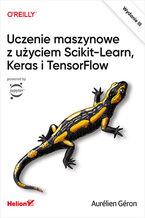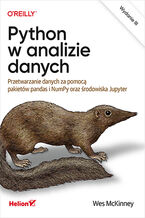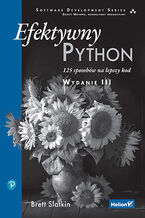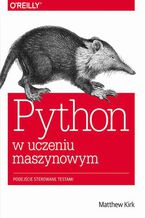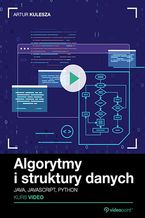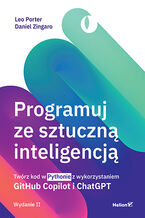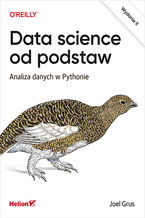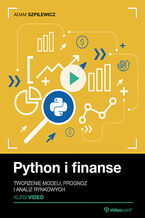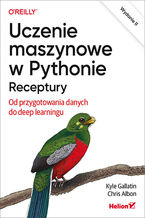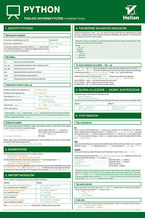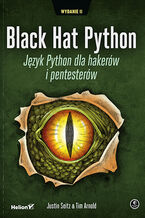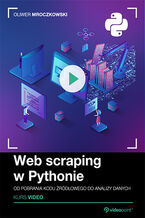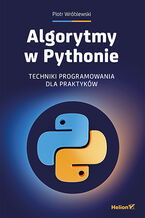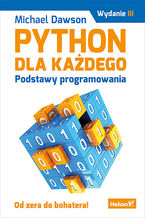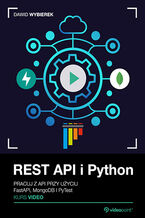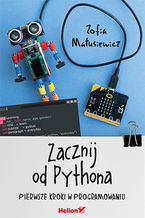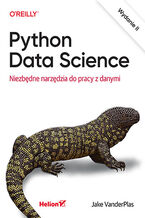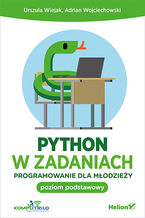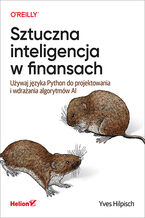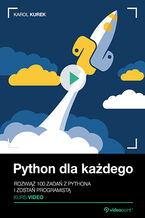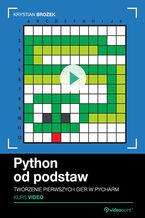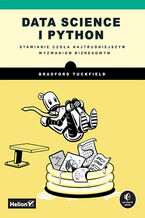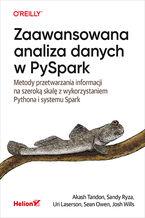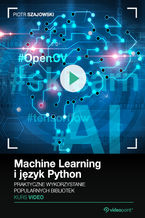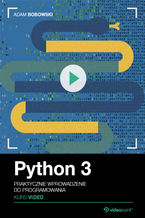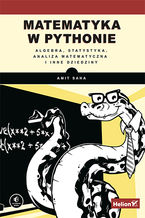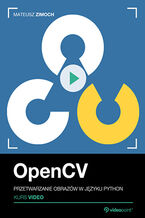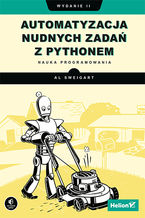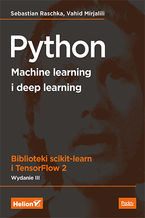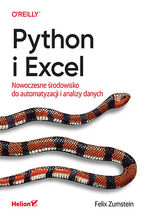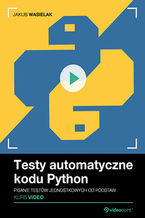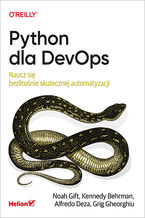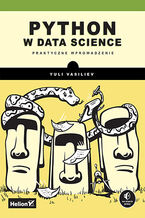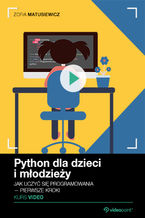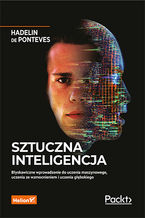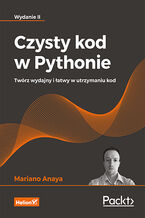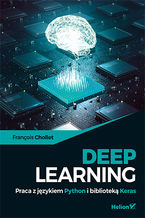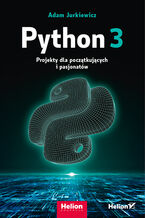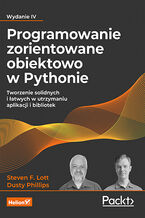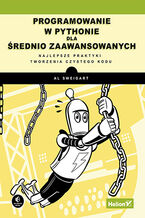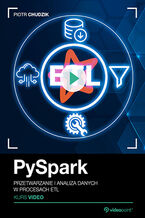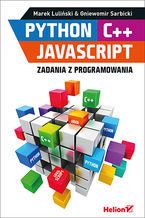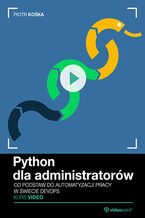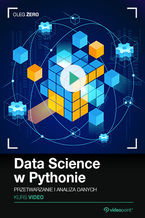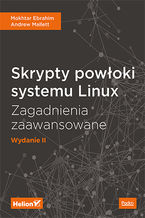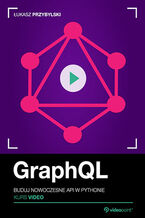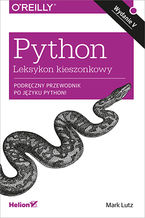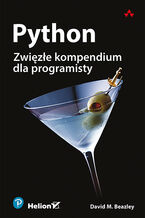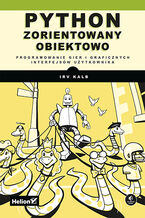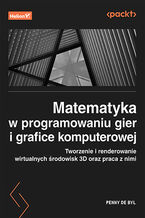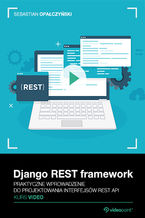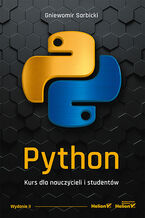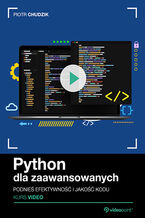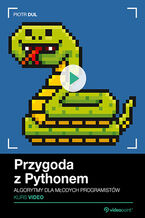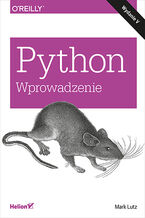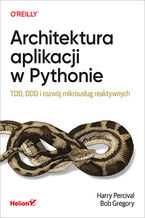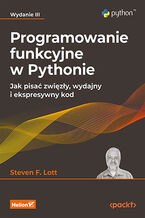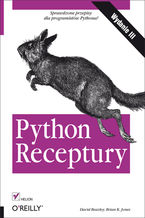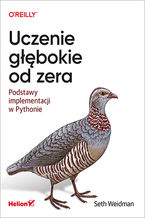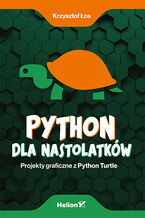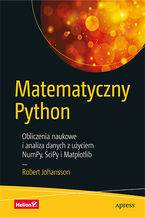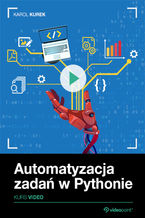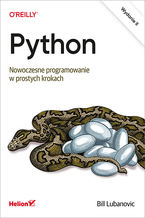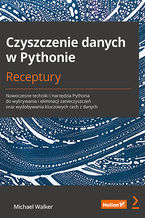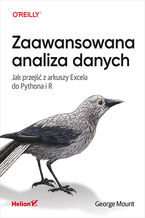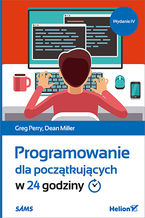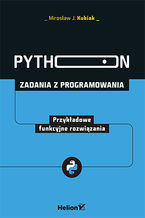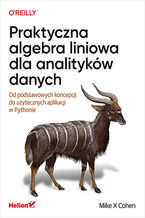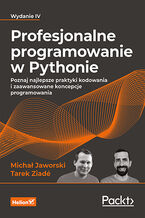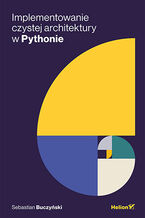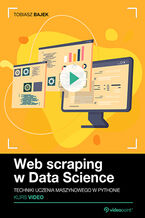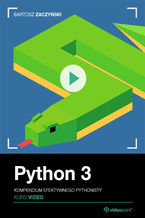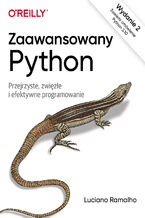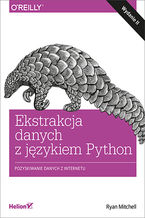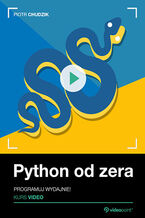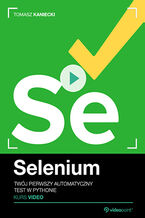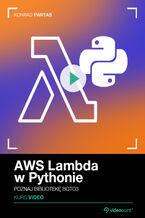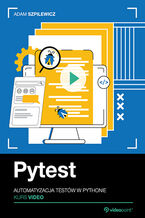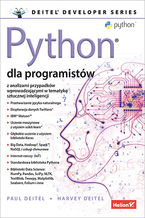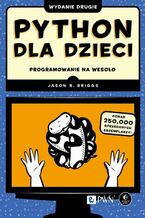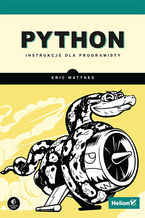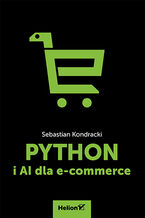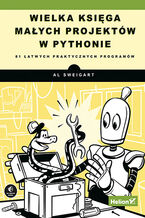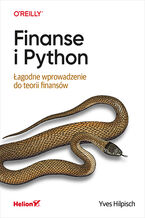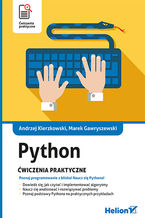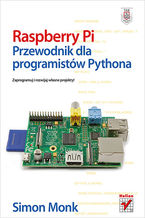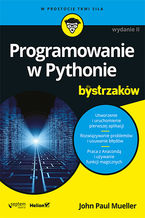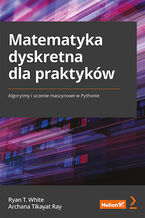W kategorii Python przedstawimy Ci szeroki wybór książek do nauki programowania, które dostosowane są do każdego poziomu umiejętności. Bez względu na to, czy jesteś początkującym programistą, czy doświadczonym developerem, te książki pomogą Ci lepiej zrozumieć koncepcje, składnię i zastosowania Pythona. W dziedzinie języków programowania Python wyróżnia się jako wszechstronne i potężne narzędzie, które zdobyło serca programistów na całym świecie. Znany ze swojej prostoty, czytelności i elastyczności, Python stał się preferowanym językiem do wielu zastosowań, od tworzenia stron internetowych po analizę danych i sztuczną inteligencję.
Python - Programowanie - książki
Książki, ebooki, kursy video z kategorii: Python - Programowanie dostępne w księgarni Helion
-
Bestseller Nowość Promocja
 Ta książka stanowi kompleksowe i obszerne wprowadzenie do języka Python. Pomoże Ci opanować jego podstawy i przygotuje do praktycznego zastosowania nabytej wiedzy. To wydanie zostało zaktualizowane i rozszerzone, aby odzwierciedlić zmiany zachodzące w świecie Pythona. Pominięto omówienie nieaktualnej wersji 2.X,opisano nowe narzędzia, dodane do Pyt
Ta książka stanowi kompleksowe i obszerne wprowadzenie do języka Python. Pomoże Ci opanować jego podstawy i przygotuje do praktycznego zastosowania nabytej wiedzy. To wydanie zostało zaktualizowane i rozszerzone, aby odzwierciedlić zmiany zachodzące w świecie Pythona. Pominięto omówienie nieaktualnej wersji 2.X,opisano nowe narzędzia, dodane do Pyt-
książka
-
ebook
(119,40 zł najniższa cena z 30 dni)
119.40 zł
199.00 zł(-40%) -
-
Bestseller Promocja
 Głębokie sieci neuronowe mają niesamowity potencjał. Osiągnięcia ostatnich lat nadały procesom uczenia głębokiego zupełnie nową jakość. Obecnie nawet programiści niezaznajomieni z tą technologią mogą korzystać z prostych i niezwykle skutecznych narzędzi, pozwalających na sprawne implementowanie programów uczących się z danych.
Głębokie sieci neuronowe mają niesamowity potencjał. Osiągnięcia ostatnich lat nadały procesom uczenia głębokiego zupełnie nową jakość. Obecnie nawet programiści niezaznajomieni z tą technologią mogą korzystać z prostych i niezwykle skutecznych narzędzi, pozwalających na sprawne implementowanie programów uczących się z danych.-
książka
-
ebook
(107,40 zł najniższa cena z 30 dni)
107.40 zł
179.00 zł(-40%) -
-
Bestseller Promocja
 Ta książka jest trzecim, starannie zaktualizowanym wydaniem wyczerpującego przewodnika po narzędziach analitycznych Pythona. Uwzględnia Pythona 3.0 i bibliotekę pandas 1.4. Została napisana w przystępny sposób, a poszczególne zagadnienia bogato zilustrowano przykładami, studiami rzeczywistych przypadków i fragmentami kodu. W trakcie lektury nauczys
Ta książka jest trzecim, starannie zaktualizowanym wydaniem wyczerpującego przewodnika po narzędziach analitycznych Pythona. Uwzględnia Pythona 3.0 i bibliotekę pandas 1.4. Została napisana w przystępny sposób, a poszczególne zagadnienia bogato zilustrowano przykładami, studiami rzeczywistych przypadków i fragmentami kodu. W trakcie lektury nauczys-
książka
-
ebook
(71,40 zł najniższa cena z 30 dni)
71.40 zł
119.00 zł(-40%) -
-
Bestseller Promocja
 To trzecie, zaktualizowane i uzupełnione wydanie bestsellerowego podręcznika programowania w Pythonie. Naukę rozpoczniesz od podstawowych koncepcji programowania. Poznasz takie pojęcia jak zmienne, listy, klasy i pętle, a następnie utrwalisz je dzięki praktycznym ćwiczeniom. Dowiesz się, jak zapewnić interaktywność programom, i nauczysz się poprawn
To trzecie, zaktualizowane i uzupełnione wydanie bestsellerowego podręcznika programowania w Pythonie. Naukę rozpoczniesz od podstawowych koncepcji programowania. Poznasz takie pojęcia jak zmienne, listy, klasy i pętle, a następnie utrwalisz je dzięki praktycznym ćwiczeniom. Dowiesz się, jak zapewnić interaktywność programom, i nauczysz się poprawn-
książka
-
ebook
(71,40 zł najniższa cena z 30 dni)
71.40 zł
119.00 zł(-40%) -
-
Bestseller Promocja
 Ta pozycja, podobnie jak inne z serii Rusz głową!, została przygotowana zgodnie z jedyną w swoim rodzaju metodyką nauczania, wykorzystującą zasady funkcjonowania ludzkiego mózgu. Dzięki zagadkom, tajemniczym historiom, angażującym ćwiczeniom i przystępnie podanej wiedzy bez trudu przyswoisz nawet dość złożone koncepcje, takie jak programowanie zori
Ta pozycja, podobnie jak inne z serii Rusz głową!, została przygotowana zgodnie z jedyną w swoim rodzaju metodyką nauczania, wykorzystującą zasady funkcjonowania ludzkiego mózgu. Dzięki zagadkom, tajemniczym historiom, angażującym ćwiczeniom i przystępnie podanej wiedzy bez trudu przyswoisz nawet dość złożone koncepcje, takie jak programowanie zori-
książka
-
ebook
(64,50 zł najniższa cena z 30 dni)
77.40 zł
129.00 zł(-40%) -
-
Bestseller Promocja
 To trzecie, zaktualizowane i uzupełnione wydanie lubianego podręcznika programowania w Pythonie. Zawiera dodatkowe rozdziały dotyczące tak ważnych zagadnień jak algorytmy i struktury danych. Zawarty w książce materiał, w tym słowniki , ułatwi Ci tworzenie solidnego i wydajnego kodu. Znajdziesz tu jasne, zwięzłe i praktyczne rady przeznaczone dla p
To trzecie, zaktualizowane i uzupełnione wydanie lubianego podręcznika programowania w Pythonie. Zawiera dodatkowe rozdziały dotyczące tak ważnych zagadnień jak algorytmy i struktury danych. Zawarty w książce materiał, w tym słowniki , ułatwi Ci tworzenie solidnego i wydajnego kodu. Znajdziesz tu jasne, zwięzłe i praktyczne rady przeznaczone dla p-
książka
-
ebook
(69,50 zł najniższa cena z 30 dni)
83.40 zł
139.00 zł(-40%) -
-
Bestseller Nowość Promocja
 Dzięki tej książce pewnie wkroczysz do fascynującego świata internetu rzeczy! Zaczniesz od podstaw: poznasz usługi internetowe, komunikację LoRa, porty GPIO, a także możliwości najnowszych mikrokontrolerów Raspberry Pi. Dowiesz się też, czym jest ROS i jak stworzyć projekt oparty na rozpoznawaniu obrazów. Krok po kroku będziesz przechodzić do coraz
Dzięki tej książce pewnie wkroczysz do fascynującego świata internetu rzeczy! Zaczniesz od podstaw: poznasz usługi internetowe, komunikację LoRa, porty GPIO, a także możliwości najnowszych mikrokontrolerów Raspberry Pi. Dowiesz się też, czym jest ROS i jak stworzyć projekt oparty na rozpoznawaniu obrazów. Krok po kroku będziesz przechodzić do coraz-
książka
-
ebook
(69,50 zł najniższa cena z 30 dni)
83.40 zł
139.00 zł(-40%) -
-
Bestseller Nowość Promocja
 W czasach, gdy wiele naszych działań przeniosło się do przestrzeni cyfrowej, tworzymy i agregujemy ogromne ilości danych. Przechowujemy je na dyskach urządzeń, mobilnych nośnikach pamięci, w chmurach, a nawet w formie załączników poczty elektronicznej. Aby uzyskać z nich jak najwięcej informacji, musimy wykonywać odpowiednie procesy analityczno-agr
W czasach, gdy wiele naszych działań przeniosło się do przestrzeni cyfrowej, tworzymy i agregujemy ogromne ilości danych. Przechowujemy je na dyskach urządzeń, mobilnych nośnikach pamięci, w chmurach, a nawet w formie załączników poczty elektronicznej. Aby uzyskać z nich jak najwięcej informacji, musimy wykonywać odpowiednie procesy analityczno-agr-
książka
-
ebook
(29,49 zł najniższa cena z 30 dni)
35.40 zł
59.00 zł(-40%) -
-
Promocja
 Ten praktyczny przewodnik pozwoli osiągnąć biegłość w stosowaniu uczenia maszynowego w codziennej pracy. Autor, Matthew Kirk, bez akademickich rozważań pokazuje, jak integrować i testować algorytmy uczenia maszynowego w swoim kodzie. Książka przedstawia wykorzystanie testów z użyciem bibliotek naukowych NumPy, Pandas, Scikit-Learn oraz SciPy
Ten praktyczny przewodnik pozwoli osiągnąć biegłość w stosowaniu uczenia maszynowego w codziennej pracy. Autor, Matthew Kirk, bez akademickich rozważań pokazuje, jak integrować i testować algorytmy uczenia maszynowego w swoim kodzie. Książka przedstawia wykorzystanie testów z użyciem bibliotek naukowych NumPy, Pandas, Scikit-Learn oraz SciPy-
ebook
(9,90 zł najniższa cena z 30 dni)
59.42 zł
69.90 zł(-15%) -
-
Promocja

 Algorytm jest pojęciem ściśle związanym z programowaniem. Jak podaje definicja, algorytm to skończony ciąg jasno zdefiniowanych czynności koniecznych do wykonania pewnego rodzaju zadań. W efekcie ich wykonania następuje rozwiązanie postawionego problemu. Brzmi informatycznie? Oczywiście - wszak algorytm może zostać zaimplementowany w postaci progra
Algorytm jest pojęciem ściśle związanym z programowaniem. Jak podaje definicja, algorytm to skończony ciąg jasno zdefiniowanych czynności koniecznych do wykonania pewnego rodzaju zadań. W efekcie ich wykonania następuje rozwiązanie postawionego problemu. Brzmi informatycznie? Oczywiście - wszak algorytm może zostać zaimplementowany w postaci progra-
kurs
(19,80 zł najniższa cena z 30 dni)
60.00 zł
99.00 zł(-39%) -
-
Nowość Promocja
 Wyobraź sobie, że zamiast mozolnego pisania kodu linijka po linijce opisujesz w języku naturalnym, jak ma działać gotowy program. I po chwili Twój ulubiony asystent AI, taki jak GitHub Copilot, generuje dobry, działający kod!
Wyobraź sobie, że zamiast mozolnego pisania kodu linijka po linijce opisujesz w języku naturalnym, jak ma działać gotowy program. I po chwili Twój ulubiony asystent AI, taki jak GitHub Copilot, generuje dobry, działający kod!-
książka
-
ebook
(53,40 zł najniższa cena z 30 dni)
53.40 zł
89.00 zł(-40%) -
-
Nowość Promocja
 Książka powstała z myślą o wszystkich, którzy zajmują się analizą danych bez względu na poziom doświadczenia. Została pomyślana tak, aby w klarowny i praktyczny sposób, krok po kroku wyjaśnić wykonywanie różnych operacji na danych: od podstawowych czynności przetwarzania danych po zaawansowane techniki obsługi dużych zbiorów. Poszczególne receptury
Książka powstała z myślą o wszystkich, którzy zajmują się analizą danych bez względu na poziom doświadczenia. Została pomyślana tak, aby w klarowny i praktyczny sposób, krok po kroku wyjaśnić wykonywanie różnych operacji na danych: od podstawowych czynności przetwarzania danych po zaawansowane techniki obsługi dużych zbiorów. Poszczególne receptury-
książka
-
ebook
(53,40 zł najniższa cena z 30 dni)
53.40 zł
89.00 zł(-40%) -
-
Nowość Promocja

 We współczesnej gospodarce rynkowej dane stały się nowym złotem. Kto nimi dysponuje, potrafi je w odpowiedni sposób przetworzyć i wyciągnąć z nich właściwe wnioski, zyskuje sporą przewagę konkurencyjną. Stąd na rynku pracy rosnące zapotrzebowanie na data engineerów – potrzebują ich wszystkie większe firmy i organizacje, których menedżerowie r
We współczesnej gospodarce rynkowej dane stały się nowym złotem. Kto nimi dysponuje, potrafi je w odpowiedni sposób przetworzyć i wyciągnąć z nich właściwe wnioski, zyskuje sporą przewagę konkurencyjną. Stąd na rynku pracy rosnące zapotrzebowanie na data engineerów – potrzebują ich wszystkie większe firmy i organizacje, których menedżerowie r-
kurs
(67,05 zł najniższa cena z 30 dni)
104.30 zł
149.00 zł(-30%) -
-
Promocja

 Stoisz przed wyborem przedmiotów maturalnych i jako jeden z nich rozważasz informatykę? To będzie świetna decyzja! Bo tu nie chodzi tylko o samą maturę, naprawdę. Zdać ją oczywiście trzeba, i to zdać dobrze – szczególnie jeśli planujesz kontynuować naukę programowania na studiach – ale umiejętność kodowania sama w sobie to jest to! Otwo
Stoisz przed wyborem przedmiotów maturalnych i jako jeden z nich rozważasz informatykę? To będzie świetna decyzja! Bo tu nie chodzi tylko o samą maturę, naprawdę. Zdać ją oczywiście trzeba, i to zdać dobrze – szczególnie jeśli planujesz kontynuować naukę programowania na studiach – ale umiejętność kodowania sama w sobie to jest to! Otwo-
kurs
(27,80 zł najniższa cena z 30 dni)
60.00 zł
139.00 zł(-57%) -
-
Promocja

 Chcesz wejść do świata IT i szybko zobaczyć efekty swojej nauki? Postaw na framework Django, który pozwala budować nowoczesne, bezpieczne i skalowalne aplikacje webowe. Dzięki przejrzystej strukturze i ogromnej liczbie gotowych komponentów Django idealnie nadaje się dla początkujących, ale spełnia też oczekiwania profesjonalistów. Nie bez powodu ko
Chcesz wejść do świata IT i szybko zobaczyć efekty swojej nauki? Postaw na framework Django, który pozwala budować nowoczesne, bezpieczne i skalowalne aplikacje webowe. Dzięki przejrzystej strukturze i ogromnej liczbie gotowych komponentów Django idealnie nadaje się dla początkujących, ale spełnia też oczekiwania profesjonalistów. Nie bez powodu ko-
kurs
(23,80 zł najniższa cena z 30 dni)
60.00 zł
119.00 zł(-50%) -
-
Promocja
 W tym przewodniku opisano zagadnienia związane z podstawami nauki o danych. Wyjaśniono niezbędne elementy matematyki i statystyki. Przedstawiono także techniki budowy potrzebnych narzędzi i sposoby działania najistotniejszych algorytmów. Książka została skonstruowana tak, aby poszczególne implementacje były jak najbardziej przejrzyste i zrozumiałe.
W tym przewodniku opisano zagadnienia związane z podstawami nauki o danych. Wyjaśniono niezbędne elementy matematyki i statystyki. Przedstawiono także techniki budowy potrzebnych narzędzi i sposoby działania najistotniejszych algorytmów. Książka została skonstruowana tak, aby poszczególne implementacje były jak najbardziej przejrzyste i zrozumiałe.-
książka
-
ebook
(47,40 zł najniższa cena z 30 dni)
47.40 zł
79.00 zł(-40%) -
-
Promocja

 Python, stanowiący czołowy temat tego kursu, jest jednym z najpopularniejszych języków programowania na świecie. Słynie z wszechstronności, czytelności i dużej społeczności użytkowników. W świecie finansów Python zyskał szczególne uznanie ze względu na swoją efektywność w analizie danych, modelowaniu finansowym i handlu algorytmicznym. Znajomość te
Python, stanowiący czołowy temat tego kursu, jest jednym z najpopularniejszych języków programowania na świecie. Słynie z wszechstronności, czytelności i dużej społeczności użytkowników. W świecie finansów Python zyskał szczególne uznanie ze względu na swoją efektywność w analizie danych, modelowaniu finansowym i handlu algorytmicznym. Znajomość te-
kurs
(188,30 zł najniższa cena z 30 dni)
188.30 zł
269.00 zł(-30%) -
-
Promocja
 Ta książka jest zwięzłym wprowadzeniem do głównych zagadnień i aspektów uczenia przez wzmacnianie i algorytmów DQL. Docenią ją zarówno naukowcy, jak i praktycy poszukujący skutecznych algorytmów, przydatnych w pracy z finansami. Znajdziesz tu wiele interesujących przykładów w języku Python, zaprezentowanych w formie najciekawszych algorytmów gotowy
Ta książka jest zwięzłym wprowadzeniem do głównych zagadnień i aspektów uczenia przez wzmacnianie i algorytmów DQL. Docenią ją zarówno naukowcy, jak i praktycy poszukujący skutecznych algorytmów, przydatnych w pracy z finansami. Znajdziesz tu wiele interesujących przykładów w języku Python, zaprezentowanych w formie najciekawszych algorytmów gotowy-
książka
-
ebook
(47,40 zł najniższa cena z 30 dni)
47.40 zł
79.00 zł(-40%) -
-
Promocja
 Język programowania ogólnego przeznaczenia Python należy obecnie do najpopularniejszych na świecie. Skąd się bierze jego fenomen? Niewątpliwie kluczowe znaczenie ma tu bardzo czytelna składnia, mocno zbliżona do składni języka naturalnego. Czyni to Pythona dość łatwym do opanowania, także dla początkujących. Osoby bardziej doświadczone doceniają go
Język programowania ogólnego przeznaczenia Python należy obecnie do najpopularniejszych na świecie. Skąd się bierze jego fenomen? Niewątpliwie kluczowe znaczenie ma tu bardzo czytelna składnia, mocno zbliżona do składni języka naturalnego. Czyni to Pythona dość łatwym do opanowania, także dla początkujących. Osoby bardziej doświadczone doceniają go-
książka
-
ebook
(35,40 zł najniższa cena z 30 dni)
35.40 zł
59.00 zł(-40%) -
-
Promocja
 Oto zaktualizowane wydanie popularnego przewodnika, dzięki któremu skorzystasz z ponad dwustu sprawdzonych receptur bazujących na najnowszych wydaniach bibliotek Pythona. Wystarczy, że skopiujesz i dostosujesz kod do swoich potrzeb. Możesz też go uruchamiać i testować za pomocą przykładowego zbioru danych. W książce znajdziesz receptury przydatne d
Oto zaktualizowane wydanie popularnego przewodnika, dzięki któremu skorzystasz z ponad dwustu sprawdzonych receptur bazujących na najnowszych wydaniach bibliotek Pythona. Wystarczy, że skopiujesz i dostosujesz kod do swoich potrzeb. Możesz też go uruchamiać i testować za pomocą przykładowego zbioru danych. W książce znajdziesz receptury przydatne d-
książka
-
ebook
(53,40 zł najniższa cena z 30 dni)
53.40 zł
89.00 zł(-40%) -
-
Promocja
 To trzecie wydanie przejrzystego przewodnika, który ułatwi Ci naukę programowania w Pythonie. Zaczniesz od przyswojenia podstawowych pojęć programistycznych, aby wkrótce płynnie posługiwać się funkcjami i strukturami danych. Zdobędziesz też umiejętność programowania zorientowanego obiektowo. W tym zaktualizowanym wydaniu znajdziesz również wskazówk
To trzecie wydanie przejrzystego przewodnika, który ułatwi Ci naukę programowania w Pythonie. Zaczniesz od przyswojenia podstawowych pojęć programistycznych, aby wkrótce płynnie posługiwać się funkcjami i strukturami danych. Zdobędziesz też umiejętność programowania zorientowanego obiektowo. W tym zaktualizowanym wydaniu znajdziesz również wskazówk-
książka
-
ebook
(44,94 zł najniższa cena z 30 dni)
44.94 zł
74.90 zł(-40%) -
-
Promocja
 W tej książce znadziesz omówienie wszystkich najważniejszych funkcji i możliwości Pythona. Zobaczysz, jak pracować w środowisku tego języka, jak używać zmiennych, instrukcji warunkowych, funkcji i typów danych. Zobaczysz, w jakich sytuacjach warto wykorzystywać pętle i moduły, jak wykonywać operacje na plikach i jak obsługiwać wyjątki. Sprawdzisz,
W tej książce znadziesz omówienie wszystkich najważniejszych funkcji i możliwości Pythona. Zobaczysz, jak pracować w środowisku tego języka, jak używać zmiennych, instrukcji warunkowych, funkcji i typów danych. Zobaczysz, w jakich sytuacjach warto wykorzystywać pętle i moduły, jak wykonywać operacje na plikach i jak obsługiwać wyjątki. Sprawdzisz,-
książka
-
ebook
(23,40 zł najniższa cena z 30 dni)
23.40 zł
39.00 zł(-40%) -
-
Promocja
 Python to jeden z najpopularniejszych dynamicznych języków programowania. Nie od dziś znajduje on zastosowanie w różnych dziedzinach informatyki, zwłaszcza jako doskonały język skryptowy. Jeśli korzystasz z niego na co dzień i chcesz szybko wyszukiwać niezbędne informacje lub odświeżyć swoją wiedzę, sięgnij po odpowiednią ściągę! Tablice informaty
Python to jeden z najpopularniejszych dynamicznych języków programowania. Nie od dziś znajduje on zastosowanie w różnych dziedzinach informatyki, zwłaszcza jako doskonały język skryptowy. Jeśli korzystasz z niego na co dzień i chcesz szybko wyszukiwać niezbędne informacje lub odświeżyć swoją wiedzę, sięgnij po odpowiednią ściągę! Tablice informaty-
książka
-
ebook
Czasowo niedostępna
-
-
Promocja
 To drugie wydanie bestsellerowego przewodnika po hakerskich możliwościach Pythona. Opisano w nim, jak tworzyć narzędzia do podsłuchiwania ruchu sieciowego, wykradania poświadczeń, prowadzenia włamań siłowych, a także jak pisać fuzzery i trojany. Książkę zaktualizowano do Pythona 3 i wzbogacono o informacje dotyczące przesuwania bitów, utrzymywania
To drugie wydanie bestsellerowego przewodnika po hakerskich możliwościach Pythona. Opisano w nim, jak tworzyć narzędzia do podsłuchiwania ruchu sieciowego, wykradania poświadczeń, prowadzenia włamań siłowych, a także jak pisać fuzzery i trojany. Książkę zaktualizowano do Pythona 3 i wzbogacono o informacje dotyczące przesuwania bitów, utrzymywania-
książka
-
ebook
(35,40 zł najniższa cena z 30 dni)
35.40 zł
59.00 zł(-40%) -
-
Promocja
 To drugie wydanie popularnego podręcznika statystyki przeznaczonego dla analityków danych. Uzupełniono je o obszerne przykłady w Pythonie oraz wyjaśnienie, jak stosować poszczególne metody statystyczne w problemach data science, a także jak ich nie używać. Skoncentrowano się też na tych zagadnieniach statystyki, które odgrywają istotną rolę w data
To drugie wydanie popularnego podręcznika statystyki przeznaczonego dla analityków danych. Uzupełniono je o obszerne przykłady w Pythonie oraz wyjaśnienie, jak stosować poszczególne metody statystyczne w problemach data science, a także jak ich nie używać. Skoncentrowano się też na tych zagadnieniach statystyki, które odgrywają istotną rolę w data-
książka
-
ebook
(52,20 zł najniższa cena z 30 dni)
52.20 zł
87.00 zł(-40%) -
-
Promocja

 Web scraping umożliwia automatyczne zbieranie i analizowanie danych z internetu. Pozwala oszczędzać czas, automatyzując rutynowe zadania i umożliwiając analizę danych w czasie rzeczywistym. Jest szeroko stosowany w biznesie – od monitorowania cen konkurencji w e-commerce, przez analizę rynkową w finansach, aż po badania naukowe. Ta cenna w do
Web scraping umożliwia automatyczne zbieranie i analizowanie danych z internetu. Pozwala oszczędzać czas, automatyzując rutynowe zadania i umożliwiając analizę danych w czasie rzeczywistym. Jest szeroko stosowany w biznesie – od monitorowania cen konkurencji w e-commerce, przez analizę rynkową w finansach, aż po badania naukowe. Ta cenna w do-
kurs
(39,80 zł najniższa cena z 30 dni)
60.00 zł
199.00 zł(-70%) -
-
Promocja
 Na szczęście dzięki tej książce poradzisz sobie z takimi wyzwaniami! Najpierw zapoznasz się z matematycznymi podstawami algorytmów ML i NLP. Zaznajomisz się również z ogólnymi technikami uczenia maszynowego i dowiesz się, w jakim stopniu dotyczą one dużych modeli językowych. Kolejnym zagadnieniem będzie przetwarzanie danych tekstowych, w tym metody
Na szczęście dzięki tej książce poradzisz sobie z takimi wyzwaniami! Najpierw zapoznasz się z matematycznymi podstawami algorytmów ML i NLP. Zaznajomisz się również z ogólnymi technikami uczenia maszynowego i dowiesz się, w jakim stopniu dotyczą one dużych modeli językowych. Kolejnym zagadnieniem będzie przetwarzanie danych tekstowych, w tym metody-
książka
-
ebook
(53,40 zł najniższa cena z 30 dni)
53.40 zł
89.00 zł(-40%) -
-
Promocja
 Wiernym czytelnikom publikacji spod znaku wydawnictwa Helion Piotra Wróblewskiego przedstawiać nie trzeba. Dość wspomnieć, że jest on autorem wielu publikacji poświęconych głównie programowaniu i obsłudze komputerów. Jego najnowsza książka, Algorytmy w Pythonie. Techniki programowania dla praktyków, to ponad 500 stron konkretnych informacji związan
Wiernym czytelnikom publikacji spod znaku wydawnictwa Helion Piotra Wróblewskiego przedstawiać nie trzeba. Dość wspomnieć, że jest on autorem wielu publikacji poświęconych głównie programowaniu i obsłudze komputerów. Jego najnowsza książka, Algorytmy w Pythonie. Techniki programowania dla praktyków, to ponad 500 stron konkretnych informacji związan-
książka
-
ebook
(77,40 zł najniższa cena z 30 dni)
77.40 zł
129.00 zł(-40%) -
-
Promocja
 Dzięki tej praktycznej książce przekonasz się, że w Excelu możesz przeprowadzić dogłębną analizę danych i wyciągnąć z nich cenną wiedzę. Wystarczy, że skorzystasz z najnowszych funkcji i narzędzi Excela. W poradniku pokazano, jak za pomocą Power Query budować przepływy pracy porządkujące dane i jak projektować w skoroszycie relacyjne modele danych
Dzięki tej praktycznej książce przekonasz się, że w Excelu możesz przeprowadzić dogłębną analizę danych i wyciągnąć z nich cenną wiedzę. Wystarczy, że skorzystasz z najnowszych funkcji i narzędzi Excela. W poradniku pokazano, jak za pomocą Power Query budować przepływy pracy porządkujące dane i jak projektować w skoroszycie relacyjne modele danych-
książka
-
ebook
(33,50 zł najniższa cena z 30 dni)
40.20 zł
67.00 zł(-40%) -
-
Promocja
 Chcesz się nauczyć programować? Świetna decyzja! Wybierz język obiektowy, łatwy w użyciu, z przejrzystą składnią. Python będzie wprost doskonały! Rozwijany od ponad 20 lat, jest dojrzałym językiem, pozwalającym tworzyć zaawansowane aplikacje dla różnych systemów operacyjnych. Ponadto posiada system automatycznego zarządzania pamięcią, który zdejmuj
Chcesz się nauczyć programować? Świetna decyzja! Wybierz język obiektowy, łatwy w użyciu, z przejrzystą składnią. Python będzie wprost doskonały! Rozwijany od ponad 20 lat, jest dojrzałym językiem, pozwalającym tworzyć zaawansowane aplikacje dla różnych systemów operacyjnych. Ponadto posiada system automatycznego zarządzania pamięcią, który zdejmuj-
książka
-
ebook
(59,40 zł najniższa cena z 30 dni)
59.40 zł
99.00 zł(-40%) -
-
Promocja

 Wiesz, czym jest REST API? Skoro rozpoczynasz przygodę z programowaniem albo jej początki masz już za sobą, pewnie wiesz - a przynajmniej znasz te terminy ze słyszenia. Mimo to przypominamy: API, czyli aplikacyjny interfejs programistyczny, to zestaw reguł określających sposób, w jaki urządzenia i aplikacje mają się ze sobą łączyć i komuniko
Wiesz, czym jest REST API? Skoro rozpoczynasz przygodę z programowaniem albo jej początki masz już za sobą, pewnie wiesz - a przynajmniej znasz te terminy ze słyszenia. Mimo to przypominamy: API, czyli aplikacyjny interfejs programistyczny, to zestaw reguł określających sposób, w jaki urządzenia i aplikacje mają się ze sobą łączyć i komuniko-
kurs
(29,80 zł najniższa cena z 30 dni)
60.00 zł
149.00 zł(-60%) -
-
Promocja
 Pierwsza odpowiedź, jaka się nasuwa, jest dość oczywista: ponieważ Python to jeden z najprostszych do nauki języków programowania. Najkrótszy program zajmuje tylko JEDNĄ linijkę. Z małą pomocą nauczyciela i naszego praktycznego zeszytu ćwiczeń każdy młody adept sztuki programowania zdoła szybko opanować podstawy tego języka i zacząć w nim pisać swo
Pierwsza odpowiedź, jaka się nasuwa, jest dość oczywista: ponieważ Python to jeden z najprostszych do nauki języków programowania. Najkrótszy program zajmuje tylko JEDNĄ linijkę. Z małą pomocą nauczyciela i naszego praktycznego zeszytu ćwiczeń każdy młody adept sztuki programowania zdoła szybko opanować podstawy tego języka i zacząć w nim pisać swo-
książka
-
ebook
(23,94 zł najniższa cena z 30 dni)
23.94 zł
39.90 zł(-40%) -
-
Promocja
 Skoro sięgasz po tę książkę, pewnie chcesz się uczyć programowania. To świetnie! Ta umiejętność z pewnością Ci się przyda ― choćby do tego, by już dziś znakomicie się bawić „w towarzystwie” komputera, ale też jako inwestycja w przyszłość, podjęta z myślą o studiach i pracy.
Skoro sięgasz po tę książkę, pewnie chcesz się uczyć programowania. To świetnie! Ta umiejętność z pewnością Ci się przyda ― choćby do tego, by już dziś znakomicie się bawić „w towarzystwie” komputera, ale też jako inwestycja w przyszłość, podjęta z myślą o studiach i pracy.-
książka
-
ebook
(22,20 zł najniższa cena z 30 dni)
22.20 zł
37.00 zł(-40%) -
-
Promocja
 Ta książka stanowi wszechstronne omówienie wszystkich bibliotek Pythona, potrzebnych naukowcom i specjalistom pracującym z danymi. Znalazł się tu dokładny opis IPythona, NumPy, Pandas, Matplotlib, Scikit-Learn i innych narzędzi. Podręcznik uwzględnia przede wszystkim ich aspekty praktyczne, dzięki czemu świetnie się sprawdzi w rozwiązywaniu codzien
Ta książka stanowi wszechstronne omówienie wszystkich bibliotek Pythona, potrzebnych naukowcom i specjalistom pracującym z danymi. Znalazł się tu dokładny opis IPythona, NumPy, Pandas, Matplotlib, Scikit-Learn i innych narzędzi. Podręcznik uwzględnia przede wszystkim ich aspekty praktyczne, dzięki czemu świetnie się sprawdzi w rozwiązywaniu codzien-
książka
-
ebook
(83,40 zł najniższa cena z 30 dni)
83.40 zł
139.00 zł(-40%) -
-
Promocja
 Python to bardzo popularny, wydajny i elastyczny język programowania ogólnego przeznaczenia, którego prosta, czytelna i zwięzła składnia zdobyła uznanie rzesz programistów na całym świecie. Duże możliwości, przenośność kodu, możliwość pisania skryptów - wszystko to sprawia, że Python znajduje zastosowanie w najróżniejszych dziedzinach i wspiera roz
Python to bardzo popularny, wydajny i elastyczny język programowania ogólnego przeznaczenia, którego prosta, czytelna i zwięzła składnia zdobyła uznanie rzesz programistów na całym świecie. Duże możliwości, przenośność kodu, możliwość pisania skryptów - wszystko to sprawia, że Python znajduje zastosowanie w najróżniejszych dziedzinach i wspiera roz-
książka
-
ebook
(35,40 zł najniższa cena z 30 dni)
35.40 zł
59.00 zł(-40%) -
-
Promocja
 Dr Yves Hilpisch szczegółowo opisuje zarówno podstawy teoretyczne, jak i praktyczne aspekty używania algorytmów sztucznej inteligencji w ramach usług i produktów finansowych. Opierając się na przykładach z języka Python, pokazuje metodyki, modele, założenia i techniki wdrażania AI, a także analizuje problemy mogące utrudniać to zadanie i przybliża
Dr Yves Hilpisch szczegółowo opisuje zarówno podstawy teoretyczne, jak i praktyczne aspekty używania algorytmów sztucznej inteligencji w ramach usług i produktów finansowych. Opierając się na przykładach z języka Python, pokazuje metodyki, modele, założenia i techniki wdrażania AI, a także analizuje problemy mogące utrudniać to zadanie i przybliża-
książka
-
ebook
(71,40 zł najniższa cena z 30 dni)
71.40 zł
119.00 zł(-40%) -
-
Promocja

 Rozpoczęcie programowania nie wymaga skomplikowanych środowisk programistycznych. A autor szkolenia Python dla każdego. Kurs video. Rozwiąż 100 zadań z Pythona i zostań programistą koncentruje się na tym, by umożliwić rzetelne opanowanie podstaw - nie tylko w teorii, ale przede wszystkim w praktyce. I nie będzie to polegało jedynie na przepisywaniu
Rozpoczęcie programowania nie wymaga skomplikowanych środowisk programistycznych. A autor szkolenia Python dla każdego. Kurs video. Rozwiąż 100 zadań z Pythona i zostań programistą koncentruje się na tym, by umożliwić rzetelne opanowanie podstaw - nie tylko w teorii, ale przede wszystkim w praktyce. I nie będzie to polegało jedynie na przepisywaniu-
kurs
(139,30 zł najniższa cena z 30 dni)
139.30 zł
199.00 zł(-30%) -
-
Promocja
 Sposobów na naukę Pythona jest sporo i powstało na ten temat mnóstwo publikacji. Jeżeli ten wybór jest właśnie przed Tobą, rozważ naukę Pythona poprzez tworzenie prostych gier. Ich programowanie to nie tylko świetna zabawa, ale też doskonała metoda rozwijania umiejętności algorytmicznych, kreatywnych i rozwiązywania problemów. Wiele popularnych dzi
Sposobów na naukę Pythona jest sporo i powstało na ten temat mnóstwo publikacji. Jeżeli ten wybór jest właśnie przed Tobą, rozważ naukę Pythona poprzez tworzenie prostych gier. Ich programowanie to nie tylko świetna zabawa, ale też doskonała metoda rozwijania umiejętności algorytmicznych, kreatywnych i rozwiązywania problemów. Wiele popularnych dzi-
kurs
(25,79 zł najniższa cena z 30 dni)
60.00 zł
129.00 zł(-53%) -
-
Promocja
 Dzięki tej książce dowiesz się, jak pozyskiwać, analizować i wizualizować dane, a potem używać ich do rozwiązywania problemów biznesowych. Wystarczy, że znasz podstawy Pythona i matematyki na poziomie liceum, aby zacząć stosować naukę o danych w codziennej pracy. Znajdziesz tu szereg praktycznych i zrozumiałych przykładów: od usprawniania działalno
Dzięki tej książce dowiesz się, jak pozyskiwać, analizować i wizualizować dane, a potem używać ich do rozwiązywania problemów biznesowych. Wystarczy, że znasz podstawy Pythona i matematyki na poziomie liceum, aby zacząć stosować naukę o danych w codziennej pracy. Znajdziesz tu szereg praktycznych i zrozumiałych przykładów: od usprawniania działalno-
książka
-
ebook
(41,40 zł najniższa cena z 30 dni)
41.40 zł
69.00 zł(-40%) -
-
Promocja
 Oto praktyczny przewodnik po wersji 3.0 systemu Spark, metodach statystycznych i rzeczywistych zbiorach danych. Omówiono w nim zasady rozwiązywania problemów analitycznych za pomocą interfejsu PySpark, z wykorzystaniem dobrych praktyk programowania w systemie Spark. Po lekturze można bezproblemowo zagłębić się we wzorce analityczne oparte na popula
Oto praktyczny przewodnik po wersji 3.0 systemu Spark, metodach statystycznych i rzeczywistych zbiorach danych. Omówiono w nim zasady rozwiązywania problemów analitycznych za pomocą interfejsu PySpark, z wykorzystaniem dobrych praktyk programowania w systemie Spark. Po lekturze można bezproblemowo zagłębić się we wzorce analityczne oparte na popula-
książka
-
ebook
Zaawansowana analiza danych w PySpark. Metody przetwarzania informacji na szeroką skalę z wykorzystaniem Pythona i systemu Spark
Akash Tandon, Sandy Ryza, Uri Laserson, Sean Owen, Josh Wills
(41,40 zł najniższa cena z 30 dni)
41.40 zł
69.00 zł(-40%) -
-
Promocja

 Uczenie maszynowe obejmuje techniki wykorzystywane najczęściej w obszarze określanym mianem sztucznej inteligencji — a właśnie ona jest w tej chwili jednym z głównych kierunków rozwoju technologicznego branży IT. Niesamowite jest to, że po odpowiednim przekształceniu wiele problemów praktycznych, inżynierskich czy też biznesowych można rozwią
Uczenie maszynowe obejmuje techniki wykorzystywane najczęściej w obszarze określanym mianem sztucznej inteligencji — a właśnie ona jest w tej chwili jednym z głównych kierunków rozwoju technologicznego branży IT. Niesamowite jest to, że po odpowiednim przekształceniu wiele problemów praktycznych, inżynierskich czy też biznesowych można rozwią-
kurs
(174,30 zł najniższa cena z 30 dni)
174.30 zł
249.00 zł(-30%) -
-
Promocja

 Python 3. Kurs video. Praktyczne wprowadzenie do programowania kończy się na poziomie podstawowym. Jego celem jest zainteresowanie uczestnika językiem i zaprezentowanie dróg rozwoju, jakie pojawiają się przed programistą znającym Pythona. Każdy, kto ukończy to szkolenie, zdobędzie solidną praktyczną bazę, dzięki której następnie samodzielnie zagłęb
Python 3. Kurs video. Praktyczne wprowadzenie do programowania kończy się na poziomie podstawowym. Jego celem jest zainteresowanie uczestnika językiem i zaprezentowanie dróg rozwoju, jakie pojawiają się przed programistą znającym Pythona. Każdy, kto ukończy to szkolenie, zdobędzie solidną praktyczną bazę, dzięki której następnie samodzielnie zagłęb-
kurs
(19,80 zł najniższa cena z 30 dni)
60.00 zł
99.00 zł(-39%) -
-
Promocja
 Mało kto lubi matematykę, zwłaszcza algebrę czy analizę matematyczną. Wydaje się trudna i niezrozumiała. Bardzo łatwo popełnić błędy podczas rozwiązywania równań różniczkowych czy całek. Jeśli jednak powierzysz najtrudniejszą i najżmudniejszą część obliczeń komputerowi, szybko się przekonasz, że to fascynująca dziedzina wiedzy. Docenisz też jej prz
Mało kto lubi matematykę, zwłaszcza algebrę czy analizę matematyczną. Wydaje się trudna i niezrozumiała. Bardzo łatwo popełnić błędy podczas rozwiązywania równań różniczkowych czy całek. Jeśli jednak powierzysz najtrudniejszą i najżmudniejszą część obliczeń komputerowi, szybko się przekonasz, że to fascynująca dziedzina wiedzy. Docenisz też jej prz-
książka
-
ebook
(47,40 zł najniższa cena z 30 dni)
47.40 zł
79.00 zł(-40%) -
-
Promocja

 Ludzkie oko jest doskonałe. Przez narząd wzroku codziennie odbieramy multum bodźców z otoczenia. Nasz mózg ma nie lada zadanie – zinterpretować to, co widzimy. To właśnie rozpoznanie i klasyfikacja obrazu mają kluczowy wpływ na rozumienie czerpanych ze świata informacji. A jak widzi komputer? Naukowcy zwykli podglądać i naś
Ludzkie oko jest doskonałe. Przez narząd wzroku codziennie odbieramy multum bodźców z otoczenia. Nasz mózg ma nie lada zadanie – zinterpretować to, co widzimy. To właśnie rozpoznanie i klasyfikacja obrazu mają kluczowy wpływ na rozumienie czerpanych ze świata informacji. A jak widzi komputer? Naukowcy zwykli podglądać i naś-
kurs
(29,80 zł najniższa cena z 30 dni)
60.00 zł
149.00 zł(-60%) -
-
Promocja
 Ta książka jest drugim wydaniem nietypowego podręcznika programowania w Pythonie. Dzięki niej nie zostaniesz mistrzem świata w kodowaniu, za to nauczysz się tworzyć programy, które oszczędzą Ci mnóstwo czasu i wysiłku. Nawet jeśli nigdy nie programowałeś, błyskawicznie opanujesz podstawy i zapoznasz się z obszerną biblioteką Pythona przeznaczoną do
Ta książka jest drugim wydaniem nietypowego podręcznika programowania w Pythonie. Dzięki niej nie zostaniesz mistrzem świata w kodowaniu, za to nauczysz się tworzyć programy, które oszczędzą Ci mnóstwo czasu i wysiłku. Nawet jeśli nigdy nie programowałeś, błyskawicznie opanujesz podstawy i zapoznasz się z obszerną biblioteką Pythona przeznaczoną do-
książka
-
ebook
Niedostępna
-
-
Promocja
 To piąte, zaktualizowane i uzupełnione wydanie bestsellerowego przewodnika po tworzeniu aplikacji internetowych za pomocą Django. Pokazano tu proces planowania i budowy atrakcyjnych aplikacji, rozwiązywania typowych problemów i implementacji najlepszych praktyk programistycznych. Podczas tworzenia aplikacji, takich jak blog, serwis społecznościowy,
To piąte, zaktualizowane i uzupełnione wydanie bestsellerowego przewodnika po tworzeniu aplikacji internetowych za pomocą Django. Pokazano tu proces planowania i budowy atrakcyjnych aplikacji, rozwiązywania typowych problemów i implementacji najlepszych praktyk programistycznych. Podczas tworzenia aplikacji, takich jak blog, serwis społecznościowy,-
książka
-
ebook
(89,40 zł najniższa cena z 30 dni)
89.40 zł
149.00 zł(-40%) -
-
Promocja
 Oto obszerny przewodnik po uczeniu maszynowym i uczeniu głębokim w Pythonie. Zawiera dokładne omówienie najważniejszych technik uczenia maszynowego oraz staranne wyjaśnienie zasad rządzących tą technologią. Poszczególne zagadnienia zilustrowano mnóstwem wyjaśnień, wizualizacji i przykładów, co znakomicie ułatwia zrozumienie materiału i sprawne rozp
Oto obszerny przewodnik po uczeniu maszynowym i uczeniu głębokim w Pythonie. Zawiera dokładne omówienie najważniejszych technik uczenia maszynowego oraz staranne wyjaśnienie zasad rządzących tą technologią. Poszczególne zagadnienia zilustrowano mnóstwem wyjaśnień, wizualizacji i przykładów, co znakomicie ułatwia zrozumienie materiału i sprawne rozp-
książka
-
ebook
(89,40 zł najniższa cena z 30 dni)
89.40 zł
149.00 zł(-40%) -
-
Promocja

 Inteligencja obliczeniowa w machine learning (ML) to zbiór zaawansowanych technik, za sprawą których komputery mogą rozwiązywać złożone problemy, ucząc się z danych, zamiast polegać na regułach programowania. Dzięki algorytmom genetycznym, inspirowanym naturalną ewolucją, można optymalizować procesy w różnych branżach – od inżynierii, przez b
Inteligencja obliczeniowa w machine learning (ML) to zbiór zaawansowanych technik, za sprawą których komputery mogą rozwiązywać złożone problemy, ucząc się z danych, zamiast polegać na regułach programowania. Dzięki algorytmom genetycznym, inspirowanym naturalną ewolucją, można optymalizować procesy w różnych branżach – od inżynierii, przez b-
kurs
(59,80 zł najniższa cena z 30 dni)
60.00 zł
299.00 zł(-80%) -
-
Promocja
 Nie musisz dłużej czekać na włączenie Pythona jako języka skryptowego Excela ? ta książka wyjaśnia, jak je połączyć i wyciągnąć z tej integracji maksimum korzyści. To wydanie przeznaczone dla zaawansowanych użytkowników Excela, którzy nie posiadają głębokiej wiedzy o Pythonie. Pokazuje, w jaki sposób manipulować danymi zawartymi w plikach Excela be
Nie musisz dłużej czekać na włączenie Pythona jako języka skryptowego Excela ? ta książka wyjaśnia, jak je połączyć i wyciągnąć z tej integracji maksimum korzyści. To wydanie przeznaczone dla zaawansowanych użytkowników Excela, którzy nie posiadają głębokiej wiedzy o Pythonie. Pokazuje, w jaki sposób manipulować danymi zawartymi w plikach Excela be-
książka
-
ebook
(52,20 zł najniższa cena z 30 dni)
52.20 zł
87.00 zł(-40%) -
-
Promocja
 Matematyka? Brr! A po co? Po co wracać do czasów szkolnych — godzin spędzonych nad niekończącymi się zadaniami domowymi? Po co rozdrapywać stare rany i przypominać sobie koszmar tkwienia pod tablicą tylko z kredą w dłoni, gdy przeciw sobie miało się wzór nie do wyprowadzenia...? W jakim celu dorosły, samodzielny programista miałby z własnej w
Matematyka? Brr! A po co? Po co wracać do czasów szkolnych — godzin spędzonych nad niekończącymi się zadaniami domowymi? Po co rozdrapywać stare rany i przypominać sobie koszmar tkwienia pod tablicą tylko z kredą w dłoni, gdy przeciw sobie miało się wzór nie do wyprowadzenia...? W jakim celu dorosły, samodzielny programista miałby z własnej w-
kurs
(29,80 zł najniższa cena z 30 dni)
60.00 zł
149.00 zł(-60%) -
-
Promocja

 Niniejsze szkolenie to doskonały przewodnik po najpopularniejszej bibliotece służącej do testowania kodu języka Python, czyli py.test. Autor kursu nie omawia wyłącznie dokumentacji — kładzie nacisk przede wszystkim na dobre nawyki i zwyczaje, które zwiększają zarówno wartość testów, jak i biegłość ich tworzenia. Osoba, która ukończy proponowa
Niniejsze szkolenie to doskonały przewodnik po najpopularniejszej bibliotece służącej do testowania kodu języka Python, czyli py.test. Autor kursu nie omawia wyłącznie dokumentacji — kładzie nacisk przede wszystkim na dobre nawyki i zwyczaje, które zwiększają zarówno wartość testów, jak i biegłość ich tworzenia. Osoba, która ukończy proponowa-
kurs
(19,80 zł najniższa cena z 30 dni)
60.00 zł
99.00 zł(-39%) -
-
Promocja
 Dzięki tej książce dowiesz się, jak sobie z tym poradzić. Znalazło się w niej krótkie wprowadzenie do Pythona oraz do automatyzacji przetwarzania tekstu i obsługi systemu plików, a także do pisania własnych narzędzi wiersza poleceń. Zaprezentowano również przydatne narzędzia linuksowe, systemy zarządzania pakietami oraz systemy budowania, monitorow
Dzięki tej książce dowiesz się, jak sobie z tym poradzić. Znalazło się w niej krótkie wprowadzenie do Pythona oraz do automatyzacji przetwarzania tekstu i obsługi systemu plików, a także do pisania własnych narzędzi wiersza poleceń. Zaprezentowano również przydatne narzędzia linuksowe, systemy zarządzania pakietami oraz systemy budowania, monitorow-
książka
-
ebook
(77,40 zł najniższa cena z 30 dni)
77.40 zł
129.00 zł(-40%) -
-
Promocja
 Tę książkę docenią średnio zaawansowani użytkownicy Pythona, którzy tworzą aplikacje korzystające z osiągnięć nauki o danych. Znajdziesz w niej omówienie możliwości języka, wbudowanych struktur danych Pythona, jak również takich bibliotek jak NumPy, pandas, scikit-learn i matplotlib. Nauczysz się wczytywania danych w różnych formatach, porządkowani
Tę książkę docenią średnio zaawansowani użytkownicy Pythona, którzy tworzą aplikacje korzystające z osiągnięć nauki o danych. Znajdziesz w niej omówienie możliwości języka, wbudowanych struktur danych Pythona, jak również takich bibliotek jak NumPy, pandas, scikit-learn i matplotlib. Nauczysz się wczytywania danych w różnych formatach, porządkowani-
książka
-
ebook
(41,40 zł najniższa cena z 30 dni)
41.40 zł
69.00 zł(-40%) -
-
Promocja
 Oto uzupełnione i zaktualizowane wydanie bestsellerowego przewodnika dla inżynierów sieci. Dzięki niemu przejdziesz trudną (ale ekscytującą!) drogę od tradycyjnej platformy do platformy sieciowej opartej na najlepszych praktykach programistycznych. Zaczniesz od zagadnień podstawowych, aby następnie zagłębić się w tajniki stosowania bibliotek Pexpec
Oto uzupełnione i zaktualizowane wydanie bestsellerowego przewodnika dla inżynierów sieci. Dzięki niemu przejdziesz trudną (ale ekscytującą!) drogę od tradycyjnej platformy do platformy sieciowej opartej na najlepszych praktykach programistycznych. Zaczniesz od zagadnień podstawowych, aby następnie zagłębić się w tajniki stosowania bibliotek Pexpec-
książka
-
ebook
(77,40 zł najniższa cena z 30 dni)
77.40 zł
129.00 zł(-40%) -
-
Promocja
 Kurs jest przeznaczony dla każdego młodego słuchacza, nawet tego, który nie miał dotąd do czynienia ze środowiskiem programistycznym, z algorytmiką i Pythonem jako takim. Wystarczą otwarta głowa i odrobina zainteresowania, aby gładko wejść w świat języka programowania i zacząć się w nim poruszać. A potężne możliwości, jakie daje umiejętność
Kurs jest przeznaczony dla każdego młodego słuchacza, nawet tego, który nie miał dotąd do czynienia ze środowiskiem programistycznym, z algorytmiką i Pythonem jako takim. Wystarczą otwarta głowa i odrobina zainteresowania, aby gładko wejść w świat języka programowania i zacząć się w nim poruszać. A potężne możliwości, jakie daje umiejętność-
kurs
(13,80 zł najniższa cena z 30 dni)
60.00 zł
69.00 zł(-13%) -
-
Promocja

 Żyjemy dosłownie zanurzeni w internecie. Nawet gdy wstajemy od komputera i wychodzimy z domu, wciąż zabieramy ze sobą sieć – do sklepu, kina, restauracji i muzeum. Chcąc skorzystać z promocji, zapłacić za parking czy kupić taniej bilet, musimy zainstalować na telefonie odpowiednią aplikację, która nam to umożliwi. W firmach i instytucj
Żyjemy dosłownie zanurzeni w internecie. Nawet gdy wstajemy od komputera i wychodzimy z domu, wciąż zabieramy ze sobą sieć – do sklepu, kina, restauracji i muzeum. Chcąc skorzystać z promocji, zapłacić za parking czy kupić taniej bilet, musimy zainstalować na telefonie odpowiednią aplikację, która nam to umożliwi. W firmach i instytucj-
kurs
(17,80 zł najniższa cena z 30 dni)
60.00 zł
89.00 zł(-33%) -
-
Promocja
 To kompletny, zwięzły przewodnik po świecie sztucznej inteligencji. Znalazły się tu przejrzyście wyłożone podstawy i bardziej zaawansowane zagadnienia. Wyjaśniono, jak najlepiej zabrać się do tworzenia systemów AI wykorzystujących uczenie ze wzmacnianiem oraz głębokie uczenie. Krok po kroku pokazano, jak zrealizować pięć praktycznych projektów. To
To kompletny, zwięzły przewodnik po świecie sztucznej inteligencji. Znalazły się tu przejrzyście wyłożone podstawy i bardziej zaawansowane zagadnienia. Wyjaśniono, jak najlepiej zabrać się do tworzenia systemów AI wykorzystujących uczenie ze wzmacnianiem oraz głębokie uczenie. Krok po kroku pokazano, jak zrealizować pięć praktycznych projektów. To-
książka
-
ebook
(47,40 zł najniższa cena z 30 dni)
47.40 zł
79.00 zł(-40%) -
-
Promocja
 Dzięki tej książce nauczysz się korzystać z kilku narzędzi służących do zarządzania projektami napisanymi w Pythonie. Dowiesz się, czym się charakteryzuje czysty kod i jakie techniki umożliwiają tworzenie czytelnego i wydajnego kodu. Przekonasz się, że do tego celu wystarczą standardowa biblioteka Pythona i zestaw najlepszych praktyk programistyczn
Dzięki tej książce nauczysz się korzystać z kilku narzędzi służących do zarządzania projektami napisanymi w Pythonie. Dowiesz się, czym się charakteryzuje czysty kod i jakie techniki umożliwiają tworzenie czytelnego i wydajnego kodu. Przekonasz się, że do tego celu wystarczą standardowa biblioteka Pythona i zestaw najlepszych praktyk programistyczn-
książka
-
ebook
(47,40 zł najniższa cena z 30 dni)
47.40 zł
79.00 zł(-40%) -
-
Promocja
 Niniejsza książka jest praktycznym przewodnikiem po uczeniu głębokim. Znalazły się tu dokładne informacje o istocie uczenia głębokiego, o jego zastosowaniach i ograniczeniach. Wyjaśniono zasady rozwiązywania typowych problemów uczenia maszynowego. Pokazano, jak korzystać z pakietu Keras przy implementacji rozpoznawania obrazu, przetwarzania języka
Niniejsza książka jest praktycznym przewodnikiem po uczeniu głębokim. Znalazły się tu dokładne informacje o istocie uczenia głębokiego, o jego zastosowaniach i ograniczeniach. Wyjaśniono zasady rozwiązywania typowych problemów uczenia maszynowego. Pokazano, jak korzystać z pakietu Keras przy implementacji rozpoznawania obrazu, przetwarzania języka-
książka
-
ebook
(47,40 zł najniższa cena z 30 dni)
47.40 zł
79.00 zł(-40%) -
-
Promocja
 Sztuczna inteligencja stale się rozwija. Właściwie codziennie słyszymy o jej rosnących możliwościach, nowych osiągnięciach i przyszłości, jaką nam przyniesie. Jednak w tej książce skupiamy się nie na przyszłości, a na teraźniejszości i praktycznym obliczu AI - na usługach, które świadczy już dziś. Większość najciekawszych zastosowań sztucznej intel
Sztuczna inteligencja stale się rozwija. Właściwie codziennie słyszymy o jej rosnących możliwościach, nowych osiągnięciach i przyszłości, jaką nam przyniesie. Jednak w tej książce skupiamy się nie na przyszłości, a na teraźniejszości i praktycznym obliczu AI - na usługach, które świadczy już dziś. Większość najciekawszych zastosowań sztucznej intel-
książka
-
ebook
(47,40 zł najniższa cena z 30 dni)
47.40 zł
79.00 zł(-40%) -
-
Promocja
 Dzięki tej książce przekonasz się, jak wspaniałą przygodą jest programowanie i jak łatwo ją zacząć! Poznasz podstawy Pythona, dowiesz się, jak pisać i formatować kod, a także szybko nauczysz się uruchamiać swoje programy. Instrukcje sterujące, operatory, typy danych, funkcje, klasy i moduły nie będą miały przed Tobą tajemnic, a to jeszcze nie konie
Dzięki tej książce przekonasz się, jak wspaniałą przygodą jest programowanie i jak łatwo ją zacząć! Poznasz podstawy Pythona, dowiesz się, jak pisać i formatować kod, a także szybko nauczysz się uruchamiać swoje programy. Instrukcje sterujące, operatory, typy danych, funkcje, klasy i moduły nie będą miały przed Tobą tajemnic, a to jeszcze nie konie-
książka
-
ebook
(41,40 zł najniższa cena z 30 dni)
41.40 zł
69.00 zł(-40%) -
-
Promocja
 Oto przyjazny przewodnik dla programistów Pythona, wyczerpująco wyjaśniający wiele zagadnień programowania obiektowego, takich jak dziedziczenie, kompozycja, polimorfizm, tworzenie klas i struktur danych. W książce szczegółowo omówiono zagadnienia obsługi wyjątków, testowania kodu i zastosowania technik programowania funkcyjnego. Opisano też dwa po
Oto przyjazny przewodnik dla programistów Pythona, wyczerpująco wyjaśniający wiele zagadnień programowania obiektowego, takich jak dziedziczenie, kompozycja, polimorfizm, tworzenie klas i struktur danych. W książce szczegółowo omówiono zagadnienia obsługi wyjątków, testowania kodu i zastosowania technik programowania funkcyjnego. Opisano też dwa po-
książka
-
ebook
(89,40 zł najniższa cena z 30 dni)
89.40 zł
149.00 zł(-40%) -
-
Promocja
 Dzięki tej książce przyswoisz najlepsze zasady konfigurowania środowiska programistycznego i praktyki programistyczne poprawiające czytelność kodu. Znajdziesz tu mnóstwo przydatnych wskazówek dotyczących posługiwania się wierszem polecenia i takimi narzędziami jak formatery kodu, kontrolery typów, lintery, a nawet systemy kontroli wersji. Od strony
Dzięki tej książce przyswoisz najlepsze zasady konfigurowania środowiska programistycznego i praktyki programistyczne poprawiające czytelność kodu. Znajdziesz tu mnóstwo przydatnych wskazówek dotyczących posługiwania się wierszem polecenia i takimi narzędziami jak formatery kodu, kontrolery typów, lintery, a nawet systemy kontroli wersji. Od strony-
książka
-
ebook
(53,40 zł najniższa cena z 30 dni)
53.40 zł
89.00 zł(-40%) -
-
Promocja

 Czy znane są Ci nazwy Apache Spark i PySpark? Jeśli pracujesz z danymi i do tej pory nie poznałeś tej technologii, najwyższy czas to nadrobić – na przykład w trakcie proponowanego przez nas szkolenia wideo. Apache Spark to otwarta platforma programistyczna służąca do obliczeń rozproszonych. Opracowana i rozwijana początkowo na Uniwersytecie K
Czy znane są Ci nazwy Apache Spark i PySpark? Jeśli pracujesz z danymi i do tej pory nie poznałeś tej technologii, najwyższy czas to nadrobić – na przykład w trakcie proponowanego przez nas szkolenia wideo. Apache Spark to otwarta platforma programistyczna służąca do obliczeń rozproszonych. Opracowana i rozwijana początkowo na Uniwersytecie K-
kurs
(104,30 zł najniższa cena z 30 dni)
104.30 zł
149.00 zł(-30%) -
-
Promocja
 Z praktycznym zestawem zawartych tu zadań spróbujesz znaleźć permutacje zbioru, zaszyfrować tekst szyfrem Cezara, zbudować trójkąt Pascala i wskazać punkty kratowe wewnątrz koła o promieniu r. Napiszesz według własnego pomysłu programy odpowiadające na postawione w zadaniach pytania. Jeśli jesteś uczniem, będziesz mógł w ten sposób ćwiczyć nie tylk
Z praktycznym zestawem zawartych tu zadań spróbujesz znaleźć permutacje zbioru, zaszyfrować tekst szyfrem Cezara, zbudować trójkąt Pascala i wskazać punkty kratowe wewnątrz koła o promieniu r. Napiszesz według własnego pomysłu programy odpowiadające na postawione w zadaniach pytania. Jeśli jesteś uczniem, będziesz mógł w ten sposób ćwiczyć nie tylk-
książka
-
ebook
(23,94 zł najniższa cena z 30 dni)
23.94 zł
39.90 zł(-40%) -
-
Promocja

 Jeśli zapytać aktywnych specjalistów branży IT o najpopularniejszy obecnie język programowania, większość z nich odpowie bez wahania: Python. Kto zatem rozważa rozpoczęcie kariery jako specjalista DevOps albo jako administrator systemów, zdecydowanie powinien zacząć naukę od opanowania tego języka, ponieważ to w nim przede wszystkim b
Jeśli zapytać aktywnych specjalistów branży IT o najpopularniejszy obecnie język programowania, większość z nich odpowie bez wahania: Python. Kto zatem rozważa rozpoczęcie kariery jako specjalista DevOps albo jako administrator systemów, zdecydowanie powinien zacząć naukę od opanowania tego języka, ponieważ to w nim przede wszystkim b-
kurs
(125,30 zł najniższa cena z 30 dni)
125.30 zł
179.00 zł(-30%) -
-
Promocja

 Ich wielka ilość z jednej strony jest wyzwaniem dla serwerów, z drugiej - ma ogromny potencjał dla osób pracujących z danymi. Dzięki nim udaje się usprawnić niemal każdą dziedzinę życia, by wspomnieć choćby medycynę, logistykę, robotykę, e-commerce. Rozwiązania pozwalające pracować z danymi opierają się na różnych podejściach: od prostych modeli cz
Ich wielka ilość z jednej strony jest wyzwaniem dla serwerów, z drugiej - ma ogromny potencjał dla osób pracujących z danymi. Dzięki nim udaje się usprawnić niemal każdą dziedzinę życia, by wspomnieć choćby medycynę, logistykę, robotykę, e-commerce. Rozwiązania pozwalające pracować z danymi opierają się na różnych podejściach: od prostych modeli cz-
kurs
(139,30 zł najniższa cena z 30 dni)
139.30 zł
199.00 zł(-30%) -
-
Promocja
 Dzięki tej książce nauczysz się wszystkiego, co jest potrzebne do pisania profesjonalnych skryptów powłoki. Dowiesz się, czym są powłoki systemu Linux, dlaczego tak ważna jest powłoka bash i w jaki sposób edytuje się skrypty. Nauczysz się pracy na zmiennych, debugowania kodu i tworzenia skryptów interaktywnych. Będziesz korzystać z instrukcji warun
Dzięki tej książce nauczysz się wszystkiego, co jest potrzebne do pisania profesjonalnych skryptów powłoki. Dowiesz się, czym są powłoki systemu Linux, dlaczego tak ważna jest powłoka bash i w jaki sposób edytuje się skrypty. Nauczysz się pracy na zmiennych, debugowania kodu i tworzenia skryptów interaktywnych. Będziesz korzystać z instrukcji warun-
książka
-
ebook
(41,40 zł najniższa cena z 30 dni)
41.40 zł
69.00 zł(-40%) -
-
Promocja

 Application programming interface, czyli słynne API - skrót dobrze znany każdemu programiście. API można zdefiniować jako interfejs programistyczny, który wyznacza sposób komunikowania się aplikacji między sobą. Dotychczas jego struktura była najczęściej określana przez styl architektoniczny REST. W 2015 roku nastąpił przełom: Facebook podzielił si
Application programming interface, czyli słynne API - skrót dobrze znany każdemu programiście. API można zdefiniować jako interfejs programistyczny, który wyznacza sposób komunikowania się aplikacji między sobą. Dotychczas jego struktura była najczęściej określana przez styl architektoniczny REST. W 2015 roku nastąpił przełom: Facebook podzielił si-
kurs
(33,80 zł najniższa cena z 30 dni)
60.00 zł
169.00 zł(-64%) -
-
Promocja
 Dzięki tej książce opanujesz podstawowe koncepcje związane z użyciem LLM. Poznasz unikatowe cechy i mocne strony kilku najważniejszych modeli (w tym GPT, Gemini, Falcon). Następnie dowiesz się, w jaki sposób LangChain, lekki framework Pythona, pozwala na projektowanie inteligentnych agentów do przetwarzania danych o nieuporządkowanej strukturze. Zn
Dzięki tej książce opanujesz podstawowe koncepcje związane z użyciem LLM. Poznasz unikatowe cechy i mocne strony kilku najważniejszych modeli (w tym GPT, Gemini, Falcon). Następnie dowiesz się, w jaki sposób LangChain, lekki framework Pythona, pozwala na projektowanie inteligentnych agentów do przetwarzania danych o nieuporządkowanej strukturze. Zn-
książka
-
ebook
(53,40 zł najniższa cena z 30 dni)
53.40 zł
89.00 zł(-40%) -
-
Promocja
 Jeżeli jednak chcesz mieć zawsze pod ręką sprawdzone źródło informacji, które pozwoli Ci w każdej sytuacji rozwiać wątpliwości, to trafiłeś na doskonałą pozycję. Należy ona do serii Leksykon kieszonkowy i charakteryzuje się niezwykle zwięzłym, przejrzystym układem najważniejszych treści oraz poręczną formą. Znajdziesz tu szczegółowe informacje na t
Jeżeli jednak chcesz mieć zawsze pod ręką sprawdzone źródło informacji, które pozwoli Ci w każdej sytuacji rozwiać wątpliwości, to trafiłeś na doskonałą pozycję. Należy ona do serii Leksykon kieszonkowy i charakteryzuje się niezwykle zwięzłym, przejrzystym układem najważniejszych treści oraz poręczną formą. Znajdziesz tu szczegółowe informacje na t-
książka
-
ebook
(35,40 zł najniższa cena z 30 dni)
35.40 zł
59.00 zł(-40%) -
-
Promocja
 Ta książka jest zwięzłym, skupionym na praktyce przewodnikiem po Pythonie w wersji 3.6 i nowszych. Dzięki niej skoncentrujesz się na rdzeniu języka i podstawowych zagadnieniach, które musisz doskonale opanować, jeśli chcesz pisać w nim dobry kod. Dowiesz się zatem, jak działa Python i jakich zasad należy przestrzegać podczas tworzenia programów, kt
Ta książka jest zwięzłym, skupionym na praktyce przewodnikiem po Pythonie w wersji 3.6 i nowszych. Dzięki niej skoncentrujesz się na rdzeniu języka i podstawowych zagadnieniach, które musisz doskonale opanować, jeśli chcesz pisać w nim dobry kod. Dowiesz się zatem, jak działa Python i jakich zasad należy przestrzegać podczas tworzenia programów, kt-
książka
-
ebook
(41,40 zł najniższa cena z 30 dni)
41.40 zł
69.00 zł(-40%) -
-
Promocja
 Oto intuicyjny przewodnik dla średnio zaawansowanych programistów Pythona, pomyślany tak, by przyswajać zasady programowania zorientowanego obiektowo podczas praktycznych ćwiczeń. Dowiesz się, jakie problemy wiążą się z zastosowaniem podejścia proceduralnego i jak dzięki podejściu obiektowemu pisać kod łatwy w utrzymaniu i rozbudowie. Nauczysz się
Oto intuicyjny przewodnik dla średnio zaawansowanych programistów Pythona, pomyślany tak, by przyswajać zasady programowania zorientowanego obiektowo podczas praktycznych ćwiczeń. Dowiesz się, jakie problemy wiążą się z zastosowaniem podejścia proceduralnego i jak dzięki podejściu obiektowemu pisać kod łatwy w utrzymaniu i rozbudowie. Nauczysz się-
książka
-
ebook
(53,40 zł najniższa cena z 30 dni)
53.40 zł
89.00 zł(-40%) -
-
Promocja
 Ta książka wyjaśni Ci rolę matematyki w tworzeniu, renderowaniu i zmienianiu wirtualnych środowisk 3D, a ponadto pozwoli odkryć tajemnice najpopularniejszych dzisiaj silników gier. Za sprawą licznych praktycznych ćwiczeń zorientujesz się, co się kryje za rysowaniem linii i kształtów graficznych, stosowaniem wektorów i wierzchołków, budowaniem i ren
Ta książka wyjaśni Ci rolę matematyki w tworzeniu, renderowaniu i zmienianiu wirtualnych środowisk 3D, a ponadto pozwoli odkryć tajemnice najpopularniejszych dzisiaj silników gier. Za sprawą licznych praktycznych ćwiczeń zorientujesz się, co się kryje za rysowaniem linii i kształtów graficznych, stosowaniem wektorów i wierzchołków, budowaniem i ren-
książka
-
ebook
(53,40 zł najniższa cena z 30 dni)
53.40 zł
89.00 zł(-40%) -
-
Promocja
 Internet rozwija się w niesamowitym tempie. Dawniej sieć WWW była prostsza ― projektanci łączyli kod PHP, HTML i zapytania do MySQL w jednym pliku. Z czasem urosła do miliardów stron, co radykalnie zmieniło jej kształt. Zmieniły się też narzędzia i sposób pracy. Dziś idealnym wyborem dewelopera aplikacji WWW jest FastAPI, nowoczesne narzędzie
Internet rozwija się w niesamowitym tempie. Dawniej sieć WWW była prostsza ― projektanci łączyli kod PHP, HTML i zapytania do MySQL w jednym pliku. Z czasem urosła do miliardów stron, co radykalnie zmieniło jej kształt. Zmieniły się też narzędzia i sposób pracy. Dziś idealnym wyborem dewelopera aplikacji WWW jest FastAPI, nowoczesne narzędzie-
książka
-
ebook
(41,40 zł najniższa cena z 30 dni)
41.40 zł
69.00 zł(-40%) -
-
Promocja

 W nowoczesnym stacku technologicznym do rozwiązań webowych aplikacje buduje się zwykle z konkretnych komponentów, do których należą: SPA (single-page application, tj. klient webowy, który komunikuje się z serwerem za pośrednictwem API), klient mobilny (Android & iOS), serwer API oraz data storage. W podejściu, w którym system buduje się właśnie z t
W nowoczesnym stacku technologicznym do rozwiązań webowych aplikacje buduje się zwykle z konkretnych komponentów, do których należą: SPA (single-page application, tj. klient webowy, który komunikuje się z serwerem za pośrednictwem API), klient mobilny (Android & iOS), serwer API oraz data storage. W podejściu, w którym system buduje się właśnie z t-
kurs
(19,80 zł najniższa cena z 30 dni)
60.00 zł
99.00 zł(-39%) -
-
Promocja
 Python to nowoczesny, potężny i uniwersalny język programowania, który zdobył dużą popularność zarówno wśród zawodowców z branży IT, jak i w szkołach i na uczelniach - jako doskonałe narzędzie do nauki programowania na różnych poziomach. Duże możliwości, prostota i zwartość składni, czytelność kodu, wszechstronność zastosowań i wsparcie wielu parad
Python to nowoczesny, potężny i uniwersalny język programowania, który zdobył dużą popularność zarówno wśród zawodowców z branży IT, jak i w szkołach i na uczelniach - jako doskonałe narzędzie do nauki programowania na różnych poziomach. Duże możliwości, prostota i zwartość składni, czytelność kodu, wszechstronność zastosowań i wsparcie wielu parad-
książka
-
ebook
(47,40 zł najniższa cena z 30 dni)
47.40 zł
79.00 zł(-40%) -
-
Promocja

 Kurs video, który dziś proponujemy, skupia się na kwestii podatności Pythona na automatyzację. Pokażemy, jak zaoszczędzić czas dzięki efektywnemu programowaniu z wykorzystaniem najlepszych technik. Dobrze, by słuchacz przed przystąpieniem do szkolenia posiadał już pewną znajomość Pythona w zakresie podstawowych typów danych, zmiennych, pętli, instr
Kurs video, który dziś proponujemy, skupia się na kwestii podatności Pythona na automatyzację. Pokażemy, jak zaoszczędzić czas dzięki efektywnemu programowaniu z wykorzystaniem najlepszych technik. Dobrze, by słuchacz przed przystąpieniem do szkolenia posiadał już pewną znajomość Pythona w zakresie podstawowych typów danych, zmiennych, pętli, instr-
kurs
(104,30 zł najniższa cena z 30 dni)
104.30 zł
149.00 zł(-30%) -
-
Promocja
 Na naszych oczach dzieje się prawdziwa rewolucja technologiczna, rozpoczęła się era sztucznej inteligencji. By móc z nią współpracować na odpowiednim poziomie, już uczniowie i studenci powinni opanować umiejętność programowania niezbędną do poruszania się w dzisiejszym świecie pełnym nowych rozwiązań technologicznych. Dlatego właśnie powstał ten ku
Na naszych oczach dzieje się prawdziwa rewolucja technologiczna, rozpoczęła się era sztucznej inteligencji. By móc z nią współpracować na odpowiednim poziomie, już uczniowie i studenci powinni opanować umiejętność programowania niezbędną do poruszania się w dzisiejszym świecie pełnym nowych rozwiązań technologicznych. Dlatego właśnie powstał ten ku-
kurs
(23,80 zł najniższa cena z 30 dni)
60.00 zł
119.00 zł(-50%) -
-
Promocja Przedsprzedaż
 Ekstrakcja danych jest procesem, w którym informacje pozyskuje się z różnych źródeł - zwykle po to, by następnie poddać je dalszej transformacji i analizie. Umiejętność pozyskiwania danych, scalania, filtrowania i obrabiania ich na rozmaite sposoby przydaje się nie tylko zawodowym analitykom. Zdolność poruszania się po świecie danych jest wysoce po
Ekstrakcja danych jest procesem, w którym informacje pozyskuje się z różnych źródeł - zwykle po to, by następnie poddać je dalszej transformacji i analizie. Umiejętność pozyskiwania danych, scalania, filtrowania i obrabiania ich na rozmaite sposoby przydaje się nie tylko zawodowym analitykom. Zdolność poruszania się po świecie danych jest wysoce po-
książka
-
ebook
(79,20 zł najniższa cena z 30 dni)
-
-
Promocja
 To kompleksowy podręcznik do nauki programowania w Pythonie. Jego piąte wydanie zostało gruntownie zaktualizowane i rozbudowane o dodatkowe treści. Omówiono tu najnowsze wersje Pythona w liniach 3.X i 2.X, czyli 3.3 i 2.7, i dodano opisy nowych lub rozszerzonych mechanizmów, takich jak obsługa formatu JSON, moduł timeit, pakiet PyPy, metoda os.pope
To kompleksowy podręcznik do nauki programowania w Pythonie. Jego piąte wydanie zostało gruntownie zaktualizowane i rozbudowane o dodatkowe treści. Omówiono tu najnowsze wersje Pythona w liniach 3.X i 2.X, czyli 3.3 i 2.7, i dodano opisy nowych lub rozszerzonych mechanizmów, takich jak obsługa formatu JSON, moduł timeit, pakiet PyPy, metoda os.pope-
książka
-
ebook
(119,40 zł najniższa cena z 30 dni)
119.40 zł
199.00 zł(-40%) -
-
Promocja
 Python zyskuje coraz większą popularność i jest wykorzystywany do tworzenia bardzo różnych aplikacji, jednak projektowanie dużych, niezawodnych systemów w tym języku bywa wyzwaniem. Rozwijanie złożonych systemów o wysokiej jakości wymaga zastosowania odpowiedniej architektury. Trudno w Pythonie stosować takie wysokopoziomowe wzorce projektowe jak a
Python zyskuje coraz większą popularność i jest wykorzystywany do tworzenia bardzo różnych aplikacji, jednak projektowanie dużych, niezawodnych systemów w tym języku bywa wyzwaniem. Rozwijanie złożonych systemów o wysokiej jakości wymaga zastosowania odpowiedniej architektury. Trudno w Pythonie stosować takie wysokopoziomowe wzorce projektowe jak a-
książka
-
ebook
(47,40 zł najniższa cena z 30 dni)
47.40 zł
79.00 zł(-40%) -
-
Promocja
 Dzięki temu praktycznemu podręcznikowi zrozumiesz, kiedy i dlaczego warto zastosować myślenie funkcyjne, a także jak korzystać z technik funkcyjnych w różnych scenariuszach. Dowiesz się również, jakie narzędzia i biblioteki przeznaczone do tego celu są dostępne w Pythonie i jak używać wyrażeń generatorowych, list składanych i dekoratorów. W tym wyd
Dzięki temu praktycznemu podręcznikowi zrozumiesz, kiedy i dlaczego warto zastosować myślenie funkcyjne, a także jak korzystać z technik funkcyjnych w różnych scenariuszach. Dowiesz się również, jakie narzędzia i biblioteki przeznaczone do tego celu są dostępne w Pythonie i jak używać wyrażeń generatorowych, list składanych i dekoratorów. W tym wyd-
książka
-
ebook
(53,40 zł najniższa cena z 30 dni)
53.40 zł
89.00 zł(-40%) -
-
Promocja
 Ta książka to sprawdzone źródło informacji na temat Pythona i jego najczęstszych zastosowań. Należy ona do cenionej serii „Receptury”, w której znajdziesz najlepsze sposoby rozwiązywania problemów. Przekonaj się, jak wydajnie operować na strukturach danych, łańcuchach znaków, tekście i liczbach. Zobacz, jak korzystać z iteratorów i gene
Ta książka to sprawdzone źródło informacji na temat Pythona i jego najczęstszych zastosowań. Należy ona do cenionej serii „Receptury”, w której znajdziesz najlepsze sposoby rozwiązywania problemów. Przekonaj się, jak wydajnie operować na strukturach danych, łańcuchach znaków, tekście i liczbach. Zobacz, jak korzystać z iteratorów i gene-
książka
-
ebook
(59,40 zł najniższa cena z 30 dni)
59.40 zł
99.00 zł(-40%) -
-
Promocja
 Ten praktyczny podręcznik, poświęcony podstawom uczenia głębokiego, zrozumiale i wyczerpująco przedstawia zasady działania sieci neuronowych z trzech różnych poziomów: matematycznego, obliczeniowego i konceptualnego. Takie podejście wynika z faktu, że dogłębne zrozumienie sieci neuronowych wymaga nie jednego, ale kilku modeli umysłowych, z których
Ten praktyczny podręcznik, poświęcony podstawom uczenia głębokiego, zrozumiale i wyczerpująco przedstawia zasady działania sieci neuronowych z trzech różnych poziomów: matematycznego, obliczeniowego i konceptualnego. Takie podejście wynika z faktu, że dogłębne zrozumienie sieci neuronowych wymaga nie jednego, ale kilku modeli umysłowych, z których-
książka
-
ebook
(47,40 zł najniższa cena z 30 dni)
47.40 zł
79.00 zł(-40%) -
-
Promocja
 Czy wiesz, czym się zajmuje programista? To ktoś, kto, używając swojego umysłu i odpowiedniego języka programowania, rozwiązuje rozmaite problemy. Programista to taki współczesny superbohater. Przychodzi, siada do komputera, szybko przebiega palcami po klawiaturze i proszę ― działa. Oczywiście, to pewne uproszczenie, ale… Brzmi ciekawie
Czy wiesz, czym się zajmuje programista? To ktoś, kto, używając swojego umysłu i odpowiedniego języka programowania, rozwiązuje rozmaite problemy. Programista to taki współczesny superbohater. Przychodzi, siada do komputera, szybko przebiega palcami po klawiaturze i proszę ― działa. Oczywiście, to pewne uproszczenie, ale… Brzmi ciekawie-
książka
-
ebook
Czasowo niedostępna
-
-
Promocja
 Mimo szacownego wieku Django wciąż pozostaje oprogramowaniem nowoczesnym i funkcjonalnym. Kolejne wersje frameworka niosą ze sobą dodatkowe usprawnienia — aktualna ma między innymi wbudowane mapowanie obiektowo-relacyjne, umożliwia migracje schematów, walidacje formularzy, panel administratora jest w niej dostępny od ręki. Dzięki tym możliwoś
Mimo szacownego wieku Django wciąż pozostaje oprogramowaniem nowoczesnym i funkcjonalnym. Kolejne wersje frameworka niosą ze sobą dodatkowe usprawnienia — aktualna ma między innymi wbudowane mapowanie obiektowo-relacyjne, umożliwia migracje schematów, walidacje formularzy, panel administratora jest w niej dostępny od ręki. Dzięki tym możliwoś-
kurs
(15,79 zł najniższa cena z 30 dni)
60.00 zł
79.00 zł(-24%) -
-
Promocja
 W tej książce wyczerpująco przedstawiono nowoczesne metody rozwiązywania problemów obliczeniowych z tak różnych dziedzin, jak badania naukowe, inżynieria, finanse czy analiza danych za pomocą Pythona i jego bibliotek. Omówiono również wiele technik, w tym obliczenia oparte na tablicach, obliczenia symboliczne, metody wizualizacji danych, numeryczne
W tej książce wyczerpująco przedstawiono nowoczesne metody rozwiązywania problemów obliczeniowych z tak różnych dziedzin, jak badania naukowe, inżynieria, finanse czy analiza danych za pomocą Pythona i jego bibliotek. Omówiono również wiele technik, w tym obliczenia oparte na tablicach, obliczenia symboliczne, metody wizualizacji danych, numeryczne-
książka
-
ebook
Czasowo niedostępna
-
-
Promocja
 Uczenie maszynowe to dziedzina o rosnącej popularności i coraz szerszym znaczeniu w dzisiejszym świecie technologiczno-biznesowym. Wiele firm i instytucji wykorzystuje je do rozwiązywania różnorodnych problemów, co stwarza duże możliwości kariery dla osób z odpowiednimi umiejętnościami. Jeśli Cię to interesuje i planujesz w przyszłości zająć się za
Uczenie maszynowe to dziedzina o rosnącej popularności i coraz szerszym znaczeniu w dzisiejszym świecie technologiczno-biznesowym. Wiele firm i instytucji wykorzystuje je do rozwiązywania różnorodnych problemów, co stwarza duże możliwości kariery dla osób z odpowiednimi umiejętnościami. Jeśli Cię to interesuje i planujesz w przyszłości zająć się za-
kurs
(39,80 zł najniższa cena z 30 dni)
60.00 zł
199.00 zł(-70%) -
-
Promocja

 Pygame to jedna z tych fantastycznych bibliotek, które pozwalają poszerzyć możliwości programowania gier i aplikacji multimedialnych w języku Python. Ostatnio zyskuje coraz większą popularność — w zeszłym roku pojawiła się jej nowa wersja, Pygame 2. Jeśli znasz już język Python i marzysz o tym, by wykorzystać go do kreowania świetnych gier, n
Pygame to jedna z tych fantastycznych bibliotek, które pozwalają poszerzyć możliwości programowania gier i aplikacji multimedialnych w języku Python. Ostatnio zyskuje coraz większą popularność — w zeszłym roku pojawiła się jej nowa wersja, Pygame 2. Jeśli znasz już język Python i marzysz o tym, by wykorzystać go do kreowania świetnych gier, n-
kurs
(49,80 zł najniższa cena z 30 dni)
60.00 zł
249.00 zł(-76%) -
-
Promocja

 Nic skuteczniej niż rutyna nie zabija kreatywności. Konieczność monotonnego powtarzania tych samych mechanicznych czynności i zadań może źle wpłynąć na jakość naszej codziennej pracy - niezależnie od tego, czym się zajmujemy. Ale uwaga: nie musi tak być. W każdym razie nie wtedy, kiedy swoją pracę wykonujemy przy komputerze, znamy w stopniu przynaj
Nic skuteczniej niż rutyna nie zabija kreatywności. Konieczność monotonnego powtarzania tych samych mechanicznych czynności i zadań może źle wpłynąć na jakość naszej codziennej pracy - niezależnie od tego, czym się zajmujemy. Ale uwaga: nie musi tak być. W każdym razie nie wtedy, kiedy swoją pracę wykonujemy przy komputerze, znamy w stopniu przynaj-
kurs
(104,30 zł najniższa cena z 30 dni)
104.30 zł
149.00 zł(-30%) -
-
Promocja
 Python nie jest językiem idealnym, jednak przybywa programistów, którzy uważają go za bliski ideału. Wyróżnia się prostotą i wszechstronnością. Jest wdzięcznym narzędziem do badania danych i tworzenia systemów sztucznej inteligencji, uwielbiają go analitycy, ekonomiści i naukowcy. Może posłużyć do tworzenia stron WWW czy aplikacji specjalnego przez
Python nie jest językiem idealnym, jednak przybywa programistów, którzy uważają go za bliski ideału. Wyróżnia się prostotą i wszechstronnością. Jest wdzięcznym narzędziem do badania danych i tworzenia systemów sztucznej inteligencji, uwielbiają go analitycy, ekonomiści i naukowcy. Może posłużyć do tworzenia stron WWW czy aplikacji specjalnego przez-
książka
-
ebook
(71,40 zł najniższa cena z 30 dni)
71.40 zł
119.00 zł(-40%) -
-
Promocja
 Ta książka jest praktycznym zbiorem gotowych do użycia receptur, podanych tak, aby maksymalnie ułatwić proces przygotowania danych do analizy. Omówiono tu takie kwestie dotyczące danych jak importowanie, ocena ich jakości, uzupełnianie braków, porządkowanie i agregacja, a także przekształcanie. Poza zwięzłym omówieniem tych zadań zaprezentowano naj
Ta książka jest praktycznym zbiorem gotowych do użycia receptur, podanych tak, aby maksymalnie ułatwić proces przygotowania danych do analizy. Omówiono tu takie kwestie dotyczące danych jak importowanie, ocena ich jakości, uzupełnianie braków, porządkowanie i agregacja, a także przekształcanie. Poza zwięzłym omówieniem tych zadań zaprezentowano naj-
książka
-
ebook
(47,40 zł najniższa cena z 30 dni)
47.40 zł
79.00 zł(-40%) -
-
Promocja

 Jaki jest najgorętszy temat w informatyce ostatnich lat? Bez wątpienia palmę pierwszeństwa dzierży sztuczna inteligencja. Jej możliwości, rozwój, sposoby, za których pośrednictwem działa. A skoro o AI mowa, to nie sposób nie poruszyć zagadnienia uczenia maszynowego: obszaru sztucznej inteligencji poświęconego algorytmom, które poprawiają się automa
Jaki jest najgorętszy temat w informatyce ostatnich lat? Bez wątpienia palmę pierwszeństwa dzierży sztuczna inteligencja. Jej możliwości, rozwój, sposoby, za których pośrednictwem działa. A skoro o AI mowa, to nie sposób nie poruszyć zagadnienia uczenia maszynowego: obszaru sztucznej inteligencji poświęconego algorytmom, które poprawiają się automa-
kurs
(125,30 zł najniższa cena z 30 dni)
125.30 zł
179.00 zł(-30%) -
-
Promocja

 Z czym kojarzy Ci się nazwa Django? Mamy nadzieję, że nie tylko z pewnym kowbojskim filmem... I nie przede wszystkim! Nawet jeśli w tym momencie jeszcze tak jest, wkrótce, po ukończeniu tego kursu, będziesz mieć już czysto programistyczne skojarzenie – z wolnym, otwartym frameworkiem napisanym w języku Python, służącym do tworzenia aplikacji
Z czym kojarzy Ci się nazwa Django? Mamy nadzieję, że nie tylko z pewnym kowbojskim filmem... I nie przede wszystkim! Nawet jeśli w tym momencie jeszcze tak jest, wkrótce, po ukończeniu tego kursu, będziesz mieć już czysto programistyczne skojarzenie – z wolnym, otwartym frameworkiem napisanym w języku Python, służącym do tworzenia aplikacji-
kurs
(39,80 zł najniższa cena z 30 dni)
60.00 zł
199.00 zł(-70%) -
-
Promocja
 Dzięki tej książce przejście od pracy z arkuszami Excela do samodzielnego tworzenia kodu w Pythonie i R będzie płynne i bezproblemowe. Rozpoczniesz od ugruntowania swoich umiejętności w Excelu i dogłębnego zrozumienia podstaw statystyki i analizy danych. Ułatwi Ci to rozpoczęcie pisania kodu w języku R i w Pythonie. Dowiesz się, jak dokładnie przeb
Dzięki tej książce przejście od pracy z arkuszami Excela do samodzielnego tworzenia kodu w Pythonie i R będzie płynne i bezproblemowe. Rozpoczniesz od ugruntowania swoich umiejętności w Excelu i dogłębnego zrozumienia podstaw statystyki i analizy danych. Ułatwi Ci to rozpoczęcie pisania kodu w języku R i w Pythonie. Dowiesz się, jak dokładnie przeb-
książka
-
ebook
(35,94 zł najniższa cena z 30 dni)
35.94 zł
59.90 zł(-40%) -
-
Promocja
 To kolejne wydanie lubianego samouczka, dzięki któremu w ramach 24 godzinnych lekcji przyswoisz solidne podstawy programowania. Zrozumiesz, jak działają programy, i nauczysz się reguł stosowanych przez profesjonalistów przy ich projektowaniu. Dowiesz się, jak wygląda świat programistów i na czym dokładnie polega programowanie w korporacjach. Znajdz
To kolejne wydanie lubianego samouczka, dzięki któremu w ramach 24 godzinnych lekcji przyswoisz solidne podstawy programowania. Zrozumiesz, jak działają programy, i nauczysz się reguł stosowanych przez profesjonalistów przy ich projektowaniu. Dowiesz się, jak wygląda świat programistów i na czym dokładnie polega programowanie w korporacjach. Znajdz-
książka
-
ebook
Czasowo niedostępna
-
-
Promocja
 Python to obecnie jeden z najpopularniejszych języków programowania, a jego znajomość zapewnia zatrudnienie w największych firmach i przy najciekawszych projektach w branży informatycznej. Szerokie możliwości, duża elastyczność i wszechstronność, przejrzystość i zwięzłość składni, czytelność i klarowność kodu, rozbudowany pakiet bibliotek standardo
Python to obecnie jeden z najpopularniejszych języków programowania, a jego znajomość zapewnia zatrudnienie w największych firmach i przy najciekawszych projektach w branży informatycznej. Szerokie możliwości, duża elastyczność i wszechstronność, przejrzystość i zwięzłość składni, czytelność i klarowność kodu, rozbudowany pakiet bibliotek standardo-
książka
-
ebook
(23,94 zł najniższa cena z 30 dni)
23.94 zł
39.90 zł(-40%) -
-
Promocja
 To książka przeznaczona dla osób, które pracują ze zbiorami danych. Jest praktycznym przewodnikiem po koncepcjach algebry liniowej, pomyślanym tak, by ułatwić ich zrozumienie i zastosowanie w użytecznych obliczeniach. Poszczególne zagadnienia przedstawiono za pomocą kodu Pythona, wraz z przykładami ich wykorzystania w nauce o danych, uczeniu maszyn
To książka przeznaczona dla osób, które pracują ze zbiorami danych. Jest praktycznym przewodnikiem po koncepcjach algebry liniowej, pomyślanym tak, by ułatwić ich zrozumienie i zastosowanie w użytecznych obliczeniach. Poszczególne zagadnienia przedstawiono za pomocą kodu Pythona, wraz z przykładami ich wykorzystania w nauce o danych, uczeniu maszyn-
książka
-
ebook
(46,20 zł najniższa cena z 30 dni)
46.20 zł
77.00 zł(-40%) -
-
Promocja

 Flask jest jednym z mikroframeworków napisanych w języku Python. Przedrostek „mikro-” oznacza tyle, że framework ten nie wymaga określonych narzędzi ani bibliotek. Bazuje na użytkowych rozszerzeniach i należy do najpopularniejszych tego typu platform Pythona. Wiele firm programistycznych i samodzielnych deweloperów używa go do tworzenia
Flask jest jednym z mikroframeworków napisanych w języku Python. Przedrostek „mikro-” oznacza tyle, że framework ten nie wymaga określonych narzędzi ani bibliotek. Bazuje na użytkowych rozszerzeniach i należy do najpopularniejszych tego typu platform Pythona. Wiele firm programistycznych i samodzielnych deweloperów używa go do tworzenia-
kurs
(27,80 zł najniższa cena z 30 dni)
60.00 zł
139.00 zł(-57%) -
-
Promocja
 Oto książka, którą docenią i osoby rozpoczynające przygodę z programowaniem, i programiści znający już inne języki. Znajdziesz tu zarówno podstawowe informacje o Pythonie, jak i wskazówki dotyczące pisania rozszerzeń, dzięki którym będziesz w stanie korzystać z atutów kilku języków. Przydatnym uzupełnieniem są liczne przykłady, pokazujące, jak rozw
Oto książka, którą docenią i osoby rozpoczynające przygodę z programowaniem, i programiści znający już inne języki. Znajdziesz tu zarówno podstawowe informacje o Pythonie, jak i wskazówki dotyczące pisania rozszerzeń, dzięki którym będziesz w stanie korzystać z atutów kilku języków. Przydatnym uzupełnieniem są liczne przykłady, pokazujące, jak rozw-
książka
-
ebook
(65,40 zł najniższa cena z 30 dni)
65.40 zł
109.00 zł(-40%) -
-
Promocja
 Praca programisty wydaje się dziś znacznie prostsza niż kilkanaście lat temu. Wydaje się taka, ponieważ ma on dostęp do niezliczonych bibliotek przypisanych do języków programowania. Gdy pojawia się problem, sięga do biblioteki ― i po sprawie. Problem rozwiązany, zgadza się? I tak, i nie. Owszem, w wypadku prostych projektów wystarczy bazowa
Praca programisty wydaje się dziś znacznie prostsza niż kilkanaście lat temu. Wydaje się taka, ponieważ ma on dostęp do niezliczonych bibliotek przypisanych do języków programowania. Gdy pojawia się problem, sięga do biblioteki ― i po sprawie. Problem rozwiązany, zgadza się? I tak, i nie. Owszem, w wypadku prostych projektów wystarczy bazowa-
książka
-
ebook
(41,40 zł najniższa cena z 30 dni)
41.40 zł
69.00 zł(-40%) -
-
Promocja

 Web scraping w data science. Kurs video. Techniki uczenia maszynowego w Pythonie pozwoli Ci zdobyć umiejętności potrzebne do sprawnego pozyskiwania informacji ze stron internetowych. Opanujesz fundamentalne wzorce i zagadnienia uczenia maszynowego, a następnie wdrożysz się w bardziej zaawansowane tajniki. Nauczysz się matematyki sieci neuronowej i
Web scraping w data science. Kurs video. Techniki uczenia maszynowego w Pythonie pozwoli Ci zdobyć umiejętności potrzebne do sprawnego pozyskiwania informacji ze stron internetowych. Opanujesz fundamentalne wzorce i zagadnienia uczenia maszynowego, a następnie wdrożysz się w bardziej zaawansowane tajniki. Nauczysz się matematyki sieci neuronowej i-
kurs
(125,30 zł najniższa cena z 30 dni)
125.30 zł
179.00 zł(-30%) -
-
Promocja

 Podczas kursu autor zwraca uwagę na typowe pułapki języka, zalecane konwencje oraz idiomy pomagające osiągnąć czytelny „Pythonic” kod. Pokazuje, jak na przestrzeni lat zmieniały się wybrane konstrukcje językowe oraz co nas czeka w niedalekiej przyszłości. Oprócz treści związanych ściśle z Pythonem dzieli się także uniwersalną wiedzą i o
Podczas kursu autor zwraca uwagę na typowe pułapki języka, zalecane konwencje oraz idiomy pomagające osiągnąć czytelny „Pythonic” kod. Pokazuje, jak na przestrzeni lat zmieniały się wybrane konstrukcje językowe oraz co nas czeka w niedalekiej przyszłości. Oprócz treści związanych ściśle z Pythonem dzieli się także uniwersalną wiedzą i o-
kurs
(29,80 zł najniższa cena z 30 dni)
60.00 zł
149.00 zł(-60%) -
-
Promocja
 Nie marnuj czasu, próbując nagiąć Pythona, aby pasował do wzorców opanowanych w innych językach programowania. Prostota Pythona pozwala szybko osiągnąć produktywność, ale często oznacza to, że nie korzystamy ze wszystkich możliwści oferowanych przez język. Dzięki nowemu wydaniu tego podręcznika nauczysz się, jak pisać wydajny, nowoczesny kod Python
Nie marnuj czasu, próbując nagiąć Pythona, aby pasował do wzorców opanowanych w innych językach programowania. Prostota Pythona pozwala szybko osiągnąć produktywność, ale często oznacza to, że nie korzystamy ze wszystkich możliwści oferowanych przez język. Dzięki nowemu wydaniu tego podręcznika nauczysz się, jak pisać wydajny, nowoczesny kod Python-
ebook
(135,32 zł najniższa cena z 30 dni)
169.14 zł
199.00 zł(-15%) -
-
Promocja
 Ta książka jest znakomitym przewodnikiem po technikach pozyskiwania danych z internetu. Przedstawiono tu również zasady gromadzenia, przekształcania i wykorzystywania danych z różnych zasobów. W kontekście ekstrakcji danych omówiono zagadnienia związane z bazami danych, serwerami sieciowymi, protokołem HTTP, językiem HTML, bezpieczeństwem sieciowym
Ta książka jest znakomitym przewodnikiem po technikach pozyskiwania danych z internetu. Przedstawiono tu również zasady gromadzenia, przekształcania i wykorzystywania danych z różnych zasobów. W kontekście ekstrakcji danych omówiono zagadnienia związane z bazami danych, serwerami sieciowymi, protokołem HTTP, językiem HTML, bezpieczeństwem sieciowym-
książka
-
ebook
Czasowo niedostępna
-
-
Promocja

 Powiedzieć, że Python jest jednym z najpopularniejszych języków programowania, to nic nie powiedzieć. Doceniają go i od lat wybierają developerzy na całym świecie. Oni go także rozwijają. Ten język programowania wysokiego poziomu jest bowiem dostępny jako projekt typu open source, z błogosławieństwem Python Software Foundation, by udoskonalać Pytho
Powiedzieć, że Python jest jednym z najpopularniejszych języków programowania, to nic nie powiedzieć. Doceniają go i od lat wybierają developerzy na całym świecie. Oni go także rozwijają. Ten język programowania wysokiego poziomu jest bowiem dostępny jako projekt typu open source, z błogosławieństwem Python Software Foundation, by udoskonalać Pytho-
kurs
(139,30 zł najniższa cena z 30 dni)
139.30 zł
199.00 zł(-30%) -
-
Promocja

 Zawód programisty jest coraz popularniejszym życiowym wyborem - wciąż bowiem rośnie zapotrzebowanie na pracowników IT, a branża oferuje absolwentom informatyki satysfakcjonujące pensje, atrakcyjne warunki pracy, często też możliwość działania zdalnego. Jeśli myślisz o obraniu tej właśnie ścieżki zawodowej (albo o zmianie aktualnej profesji na IT),
Zawód programisty jest coraz popularniejszym życiowym wyborem - wciąż bowiem rośnie zapotrzebowanie na pracowników IT, a branża oferuje absolwentom informatyki satysfakcjonujące pensje, atrakcyjne warunki pracy, często też możliwość działania zdalnego. Jeśli myślisz o obraniu tej właśnie ścieżki zawodowej (albo o zmianie aktualnej profesji na IT),-
kurs
(97,29 zł najniższa cena z 30 dni)
97.29 zł
139.00 zł(-30%) -
-
Promocja

 Amazon Web Services (AWS) to obecnie najpopularniejsza chmura publiczna. Jednym z ważniejszych serwisów AWS jest AWS Lambda – platforma serverless, która umożliwia uruchamianie kodu bez konieczności zarządzania infrastrukturą. Lambda może automatycznie skalować aplikacje, obsługując setki tysięcy żądań w ciągu sekundy, bez dodatkowej konfigur
Amazon Web Services (AWS) to obecnie najpopularniejsza chmura publiczna. Jednym z ważniejszych serwisów AWS jest AWS Lambda – platforma serverless, która umożliwia uruchamianie kodu bez konieczności zarządzania infrastrukturą. Lambda może automatycznie skalować aplikacje, obsługując setki tysięcy żądań w ciągu sekundy, bez dodatkowej konfigur-
kurs
(31,80 zł najniższa cena z 30 dni)
60.00 zł
159.00 zł(-62%) -
-
Promocja

 Pytest – nowoczesny framework do uruchamiania testów automatycznych w języku Python. Można używać tej platformy do przeprowadzania testów jednostkowych, ale sprawdzi się świetnie także podczas konstruowania rozbudowanych testów wyższego poziomu (integracyjnych, end-to-end) dla całych aplikacji czy bibliotek. Z Pytestu do testowania kodu korzy
Pytest – nowoczesny framework do uruchamiania testów automatycznych w języku Python. Można używać tej platformy do przeprowadzania testów jednostkowych, ale sprawdzi się świetnie także podczas konstruowania rozbudowanych testów wyższego poziomu (integracyjnych, end-to-end) dla całych aplikacji czy bibliotek. Z Pytestu do testowania kodu korzy-
kurs
(104,30 zł najniższa cena z 30 dni)
104.30 zł
149.00 zł(-30%) -
-
Promocja
 Ta książka ułatwi naukę Pythona metodą analizy i eksperymentów. Zawiera ponad 500 przykładów faktycznie wykorzystywanego kodu — od krótkich bloków po kompletne studia przypadków. Pokazano, w jaki sposób można kodować w interpreterze IPython i notatnikach Jupytera. Znalazł się tu obszerny opis Pythona oraz jego instrukcji sterujących i funkcji
Ta książka ułatwi naukę Pythona metodą analizy i eksperymentów. Zawiera ponad 500 przykładów faktycznie wykorzystywanego kodu — od krótkich bloków po kompletne studia przypadków. Pokazano, w jaki sposób można kodować w interpreterze IPython i notatnikach Jupytera. Znalazł się tu obszerny opis Pythona oraz jego instrukcji sterujących i funkcji-
książka
-
ebook
(83,40 zł najniższa cena z 30 dni)
83.40 zł
139.00 zł(-40%) -
-
Promocja
 Nowe, drugie wydanie bestsellerowej książki, która jest atrakcyjnym wprowadzeniem do świata programowania. Została ona całkowicie zaktualizowana, poprawiona i dostosowana do najnowszej wersji Pythona. Zawiera nowe zadania i łamigłówki. Książka ta została napisana z myślą o Tobie i Twoich rodzicach. Przeznaczona jest dla dzieci od lat 10. Autor oma
Nowe, drugie wydanie bestsellerowej książki, która jest atrakcyjnym wprowadzeniem do świata programowania. Została ona całkowicie zaktualizowana, poprawiona i dostosowana do najnowszej wersji Pythona. Zawiera nowe zadania i łamigłówki. Książka ta została napisana z myślą o Tobie i Twoich rodzicach. Przeznaczona jest dla dzieci od lat 10. Autor oma-
ebook
(57,49 zł najniższa cena z 30 dni)
59.20 zł
74.00 zł(-20%) -
-
Promocja
 Niniejsza książka jest zwięzłym, praktycznym podręcznikiem programowania w Pythonie, dzięki któremu gruntownie opanujesz podstawy języka i nabierzesz dobrych nawyków w programowaniu. Szybko będziesz mógł skoncentrować się na praktycznej stronie realizacji projektów, a nowo poznane koncepcje wypróbujesz przez rozwiązywanie konkretnych problemów. W t
Niniejsza książka jest zwięzłym, praktycznym podręcznikiem programowania w Pythonie, dzięki któremu gruntownie opanujesz podstawy języka i nabierzesz dobrych nawyków w programowaniu. Szybko będziesz mógł skoncentrować się na praktycznej stronie realizacji projektów, a nowo poznane koncepcje wypróbujesz przez rozwiązywanie konkretnych problemów. W t-
książka
-
ebook
Niedostępna
-
-
Promocja
 E-commerce wspierany przez potężną moc sztucznej inteligencji ― to dla wielu właścicieli rodzimych firm internetowych wciąż brzmi jak odległa przyszłość. Może gdzieś tam, w Kalifornii, może u technologicznych gigantów, może Apple, Amazon, a bliżej nas, powiedzmy, Allegro korzysta lub będzie korzystać z chatbotów czy data-driven marketingu. Al
E-commerce wspierany przez potężną moc sztucznej inteligencji ― to dla wielu właścicieli rodzimych firm internetowych wciąż brzmi jak odległa przyszłość. Może gdzieś tam, w Kalifornii, może u technologicznych gigantów, może Apple, Amazon, a bliżej nas, powiedzmy, Allegro korzysta lub będzie korzystać z chatbotów czy data-driven marketingu. Al-
książka
-
ebook
(77,40 zł najniższa cena z 30 dni)
77.40 zł
129.00 zł(-40%) -
-
Promocja
 Tę książkę docenią ci, którzy opanowali już podstawową składnię Pythona i palą się do pisania własnych programów. Zawiera 81 projektów, które możesz napisać w tym języku. Programy składają się z maksymalnie 256 linii kodu i pozwolą Ci stopniowo nabierać umiejętności programisty - a zupełnie przy okazji dostarczą mnóstwo zabawy! Twoja nauka będzie p
Tę książkę docenią ci, którzy opanowali już podstawową składnię Pythona i palą się do pisania własnych programów. Zawiera 81 projektów, które możesz napisać w tym języku. Programy składają się z maksymalnie 256 linii kodu i pozwolą Ci stopniowo nabierać umiejętności programisty - a zupełnie przy okazji dostarczą mnóstwo zabawy! Twoja nauka będzie p-
książka
-
ebook
Czasowo niedostępna
-
-
Promocja
 Rozwój technologii i dostęp do danych finansowych stały się ogromnym ułatwieniem w korzystaniu z globalnych rynków finansowych. Jeśli zechcesz, możesz szybko zacząć przygodę na przykład z handlem algorytmicznym. Wystarczy, że masz niewielkie pojęcie o matematyce, programowaniu i ekonomii. Niestety, nieliczne programy nauczania o finansach integrują
Rozwój technologii i dostęp do danych finansowych stały się ogromnym ułatwieniem w korzystaniu z globalnych rynków finansowych. Jeśli zechcesz, możesz szybko zacząć przygodę na przykład z handlem algorytmicznym. Wystarczy, że masz niewielkie pojęcie o matematyce, programowaniu i ekonomii. Niestety, nieliczne programy nauczania o finansach integrują-
książka
-
ebook
Czasowo niedostępna
-
-
Promocja
 Python to niezwykle wydajny i wszechstronny język programowania, który znajduje zastosowanie w różnych dziedzinach informatyki. Stanowi fundament rozwiązań wykorzystywanych przez YouTube’a czy aplikacje Google'a. Czytelność i zwięzłość kodu, szeroki wybór bibliotek standardowych oraz wsparcie ze strony producentów różnych systemów operacyjnyc
Python to niezwykle wydajny i wszechstronny język programowania, który znajduje zastosowanie w różnych dziedzinach informatyki. Stanowi fundament rozwiązań wykorzystywanych przez YouTube’a czy aplikacje Google'a. Czytelność i zwięzłość kodu, szeroki wybór bibliotek standardowych oraz wsparcie ze strony producentów różnych systemów operacyjnyc-
książka
-
ebook
Czasowo niedostępna
-
-
Promocja
 Jest to przewodnik, dzięki któremu nauczysz się tworzyć oprogramowanie dla Pi przy użyciu języka Python i edytora IDLE. W trakcie lektury dowiesz się, jak skonfigurować Pi, jakie akcesoria będą Ci potrzebne oraz jak to wszystko połączyć w całość. W kolejnych rozdziałach zaznajomisz się z podstawami obsługi systemu operacyjnego Linux oraz prz
Jest to przewodnik, dzięki któremu nauczysz się tworzyć oprogramowanie dla Pi przy użyciu języka Python i edytora IDLE. W trakcie lektury dowiesz się, jak skonfigurować Pi, jakie akcesoria będą Ci potrzebne oraz jak to wszystko połączyć w całość. W kolejnych rozdziałach zaznajomisz się z podstawami obsługi systemu operacyjnego Linux oraz prz-
książka
-
ebook
Czasowo niedostępna
-
-
Promocja
 Oferujący potężne możliwości i dynamiczny Python jest używany do tworzenia wielu różnych aplikacji. Został opracowany jako prawdziwie niezależny od platformy — dzięki temu jest doskonałym narzędziem dla początkujących programistów, zwłaszcza tych, którzy chcą szybko poznać nowy język. Zamieszczone w książce polecenia pozwalają w dość krótkim
Oferujący potężne możliwości i dynamiczny Python jest używany do tworzenia wielu różnych aplikacji. Został opracowany jako prawdziwie niezależny od platformy — dzięki temu jest doskonałym narzędziem dla początkujących programistów, zwłaszcza tych, którzy chcą szybko poznać nowy język. Zamieszczone w książce polecenia pozwalają w dość krótkim-
książka
-
ebook
Czasowo niedostępna
-
-
Promocja
 Ta książka jest kompleksowym wprowadzeniem do matematyki dyskretnej, przydatnym dla każdego, kto chce pogłębić i ugruntować swoje umiejętności informatyczne. W zrozumiały sposób przedstawiono tu metody matematyki dyskretnej i ich zastosowanie w algorytmach i analizie danych, włączając w to techniki uczenia maszynowego. Zaprezentowano również zasady
Ta książka jest kompleksowym wprowadzeniem do matematyki dyskretnej, przydatnym dla każdego, kto chce pogłębić i ugruntować swoje umiejętności informatyczne. W zrozumiały sposób przedstawiono tu metody matematyki dyskretnej i ich zastosowanie w algorytmach i analizie danych, włączając w to techniki uczenia maszynowego. Zaprezentowano również zasady-
książka
-
ebook
Czasowo niedostępna
-
Dlaczego Python?
Czysta i intuicyjna składnia Pythona czyni go idealnym wyborem dla początkujących. Dzięki wykorzystaniu wcięć do definiowania bloków kodu, kod Pythona jest łatwy do zrozumienia, nawet dla tych, którzy dopiero zaczynają programować. Ta prostota przyspiesza krzywą nauki i zachęca programistów do skupienia się na rozwiązywaniu problemów, a nie na skomplikowanej składni. Język Python cechuje duża wszechstronność, więc jeśli fascynuje Cię analiza danych, tworzenie gier, aplikacje webowe czy tematy uczenia maszynowego i sztucznej inteligencji, nasze książki dostarczą Ci wiedzę i narzędzia niezbędne do eksploracji tych obszarów.
Książki Python dla początkujących
Książki do nauki programowania w języku Python to idealna propozycja dla tych, którzy dopiero stawiają swoje pierwsze kroki w programowaniu. Nasze książki skupiają się na podstawach tego języka, zapewniając czytelne i zrozumiałe wyjaśnienia. Wszystkie z naszych pozycji są dostępne również w formacie PDF, MOBI, EPUB, umożliwiając elastyczne korzystanie z materiałów. Jeśli szukasz kursu Python dla początkujących, mamy dla ciebie także różnorodne szkolenia video, które krok po kroku wprowadzą cię w świat programowania.
Dla tych, którzy pragną zdobyć solidne fundamenty w programowaniu w Pythonie, nasze książki stanowią cenne źródło wiedzy. Książka Python. Wprowadzenie to kluczowy element Twojej podróży ku opanowaniu tego wszechstronnego języka. Bez względu na to, czy jesteś początkującym, czy doświadczonym programistą, nasze książki o programowaniu w Pythonie zapewnią Ci bogate i praktyczne materiały.
Czy nauka Pythona jest trudna?
Absolutnie nie, zwłaszcza gdy sięgniesz po klarowne porady z książki Python. Instrukcje dla programisty. Dzięki lekturze, nauka programowania stanie się satysfakcjonującym procesem, a Ty zdobędziesz pewność w posługiwaniu się językiem Python.
Rozpoczęcie nauki programowania może być niezwykle ekscytujące, a my oferujemy najlepsze książki do nauki Pythona, które uczynią tę podróż jeszcze bardziej fascynującą. Niezależnie czy preferujesz programowanie funkcyjne, obiektowe czy strukturalne w Pythonie, mamy dla ciebie odpowiednie źródła wiedzy.
Nie ma znaczenia, czy jesteś doświadczonym programistą Pythona, który pragnie pogłębić swoją wiedzę, czy też zupełnie początkującym w programowaniu – nasze książki dostosowane są do każdego poziomu umiejętności. Znajdziesz u nas książki dla dzieci uczące podstaw programowania Python w sposób przystępny i zabawny. Jeśli jesteś zaawansowanym Python Developerem, również znajdziesz u nas wartościowe materiały.
Python dla specjalistów z innych dziedzin: książki dla zaawansowanych
Oferujemy również bogaty wybór książek dotyczących zaawansowanego Pythona, czystego kodu w Pythonie, data science, uczenia maszynowego, głębokiego uczenia oraz tworzenia aplikacji webowych. Bez względu na to, czy potrzebujesz książki ułatwiającej zrozumienie zaawansowanych koncepcji, czy materiałów pomagających tworzyć efektywny i zrozumiały kod, wszystko to znajdziesz na Helion.pl.
Nasza kolekcja to prawdziwa skarbnica wiedzy, która umożliwi Ci nie tylko naukę, ale także praktyczne zastosowanie zdobytych umiejętności. Znajdziesz u nas najlepsze książki o Pythonie dla początkujących oraz dla tych, którzy chcą pójść o krok dalej. Wszystko to, byś mógł stworzyć solidne fundamenty języka Python i zdobyć pewność w programowaniu. Dzięki naszym książkom, nauka programowania stanie się pasjonującą podróżą, a tworzenie kodu przestanie być tajemnicą.

